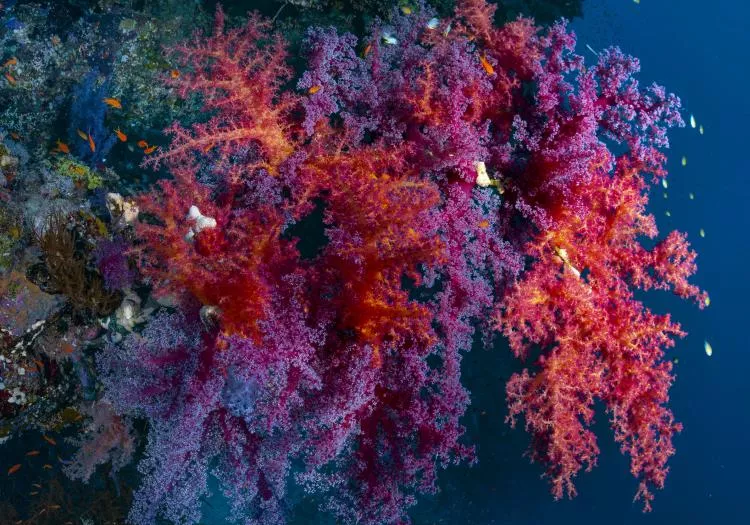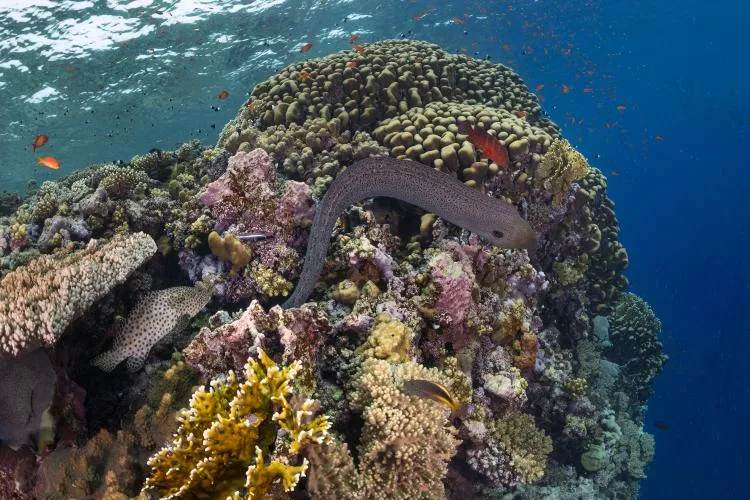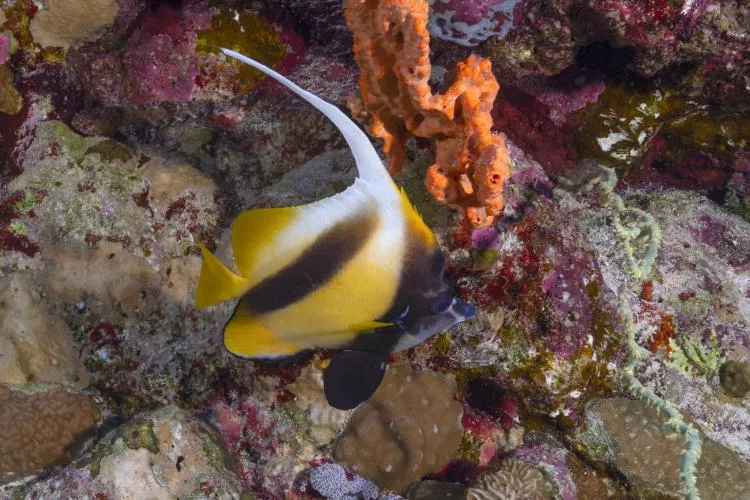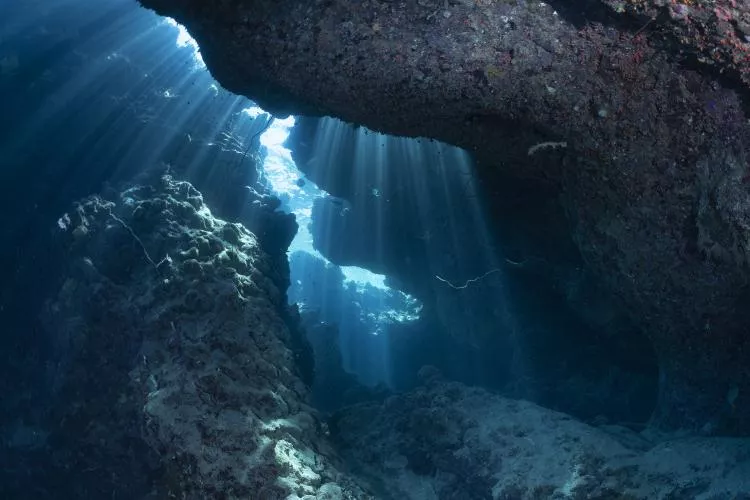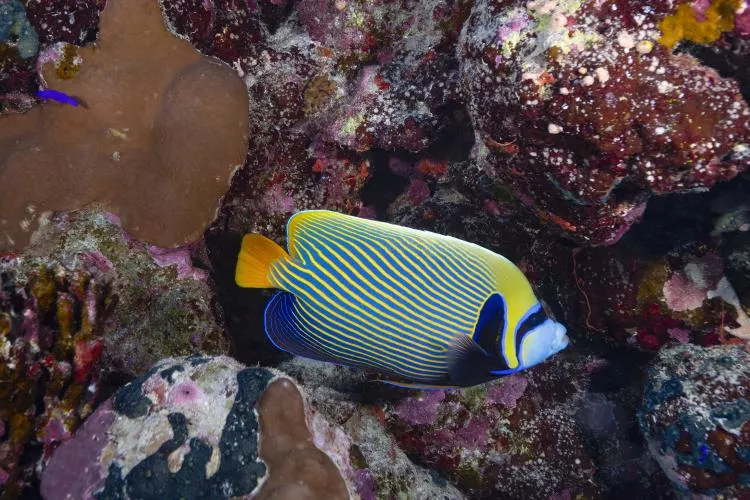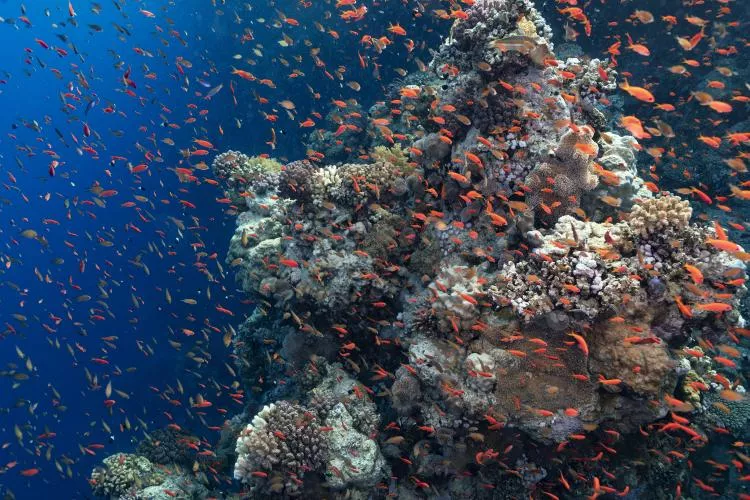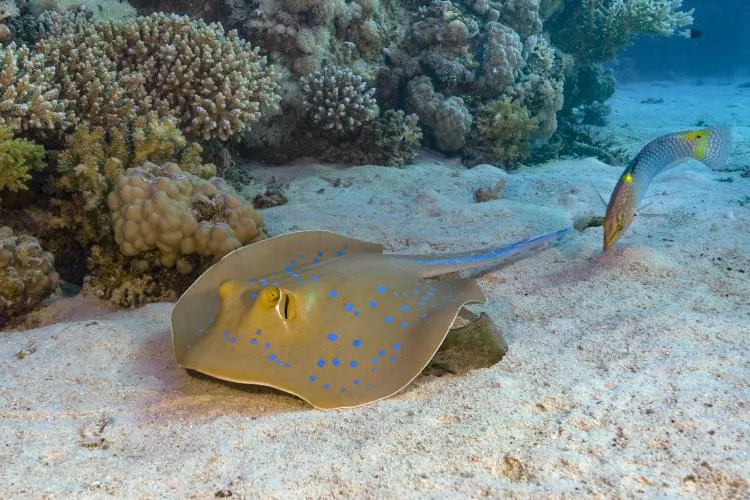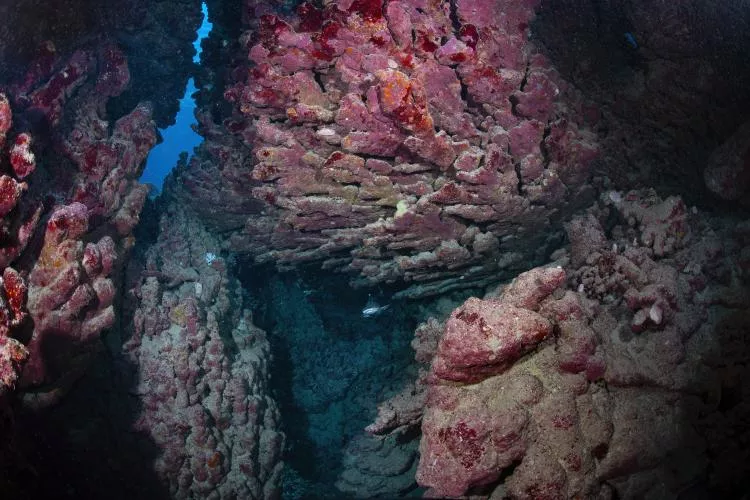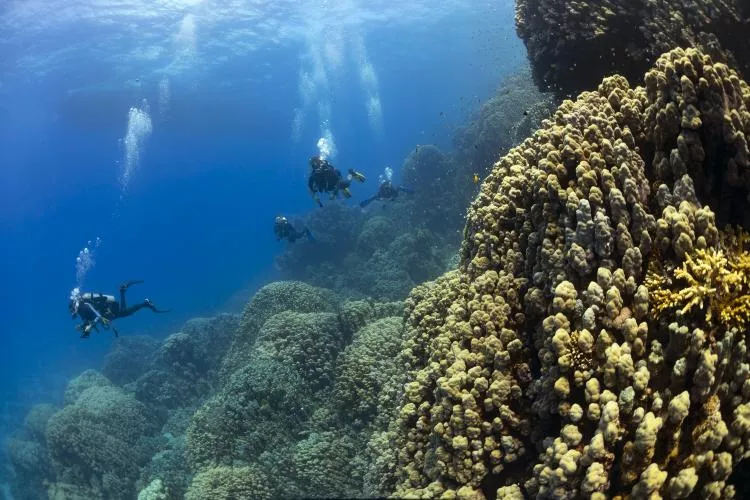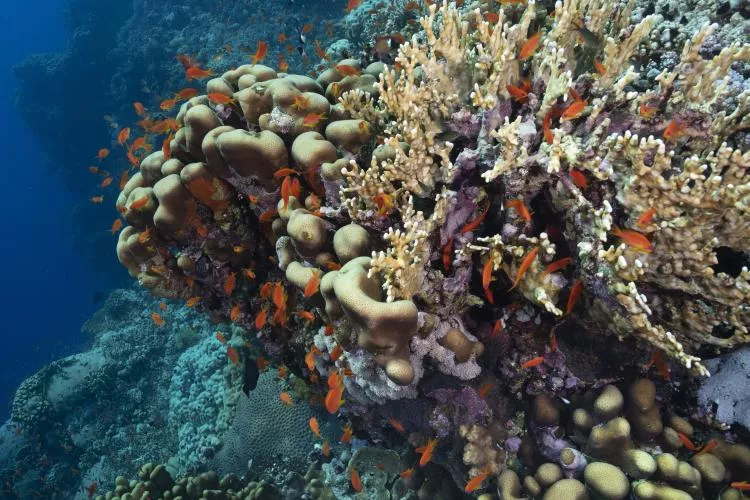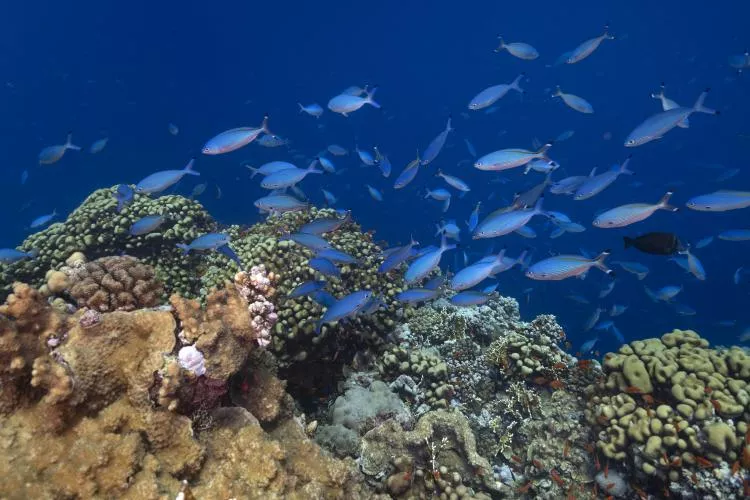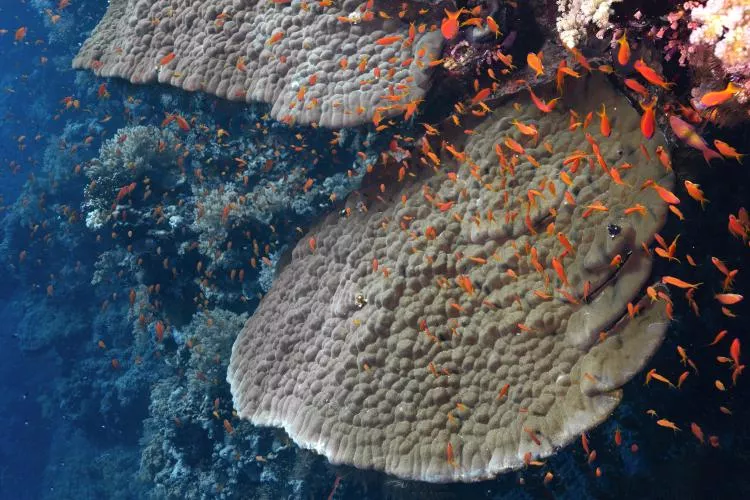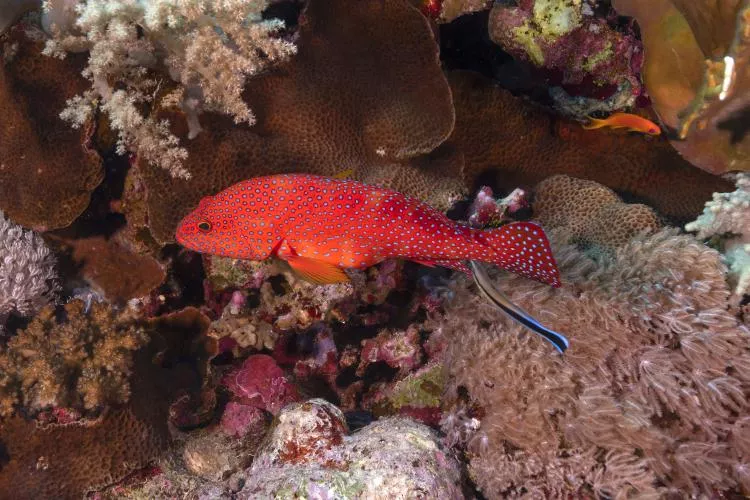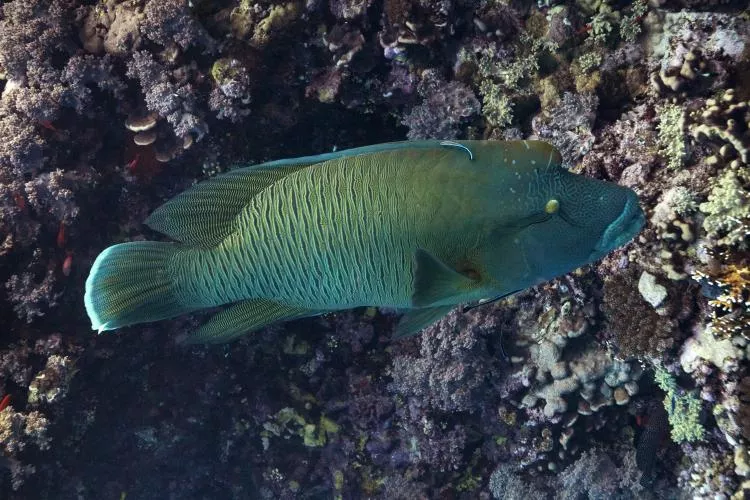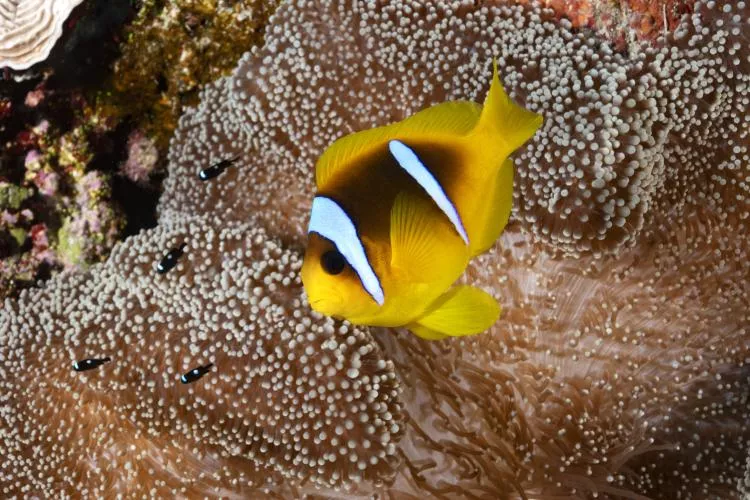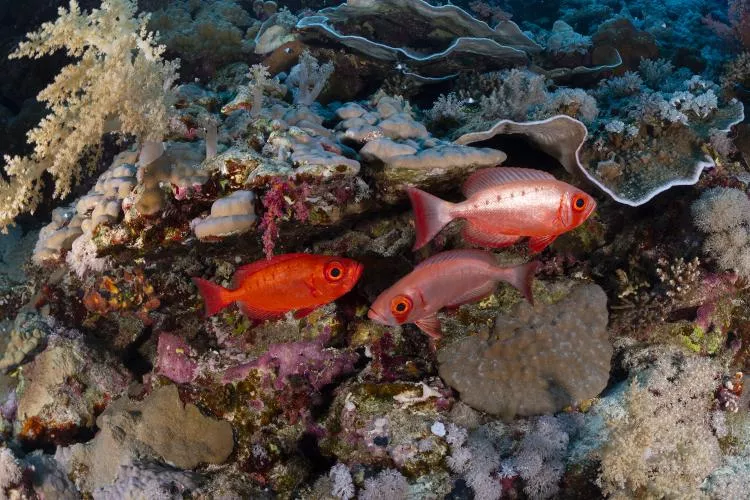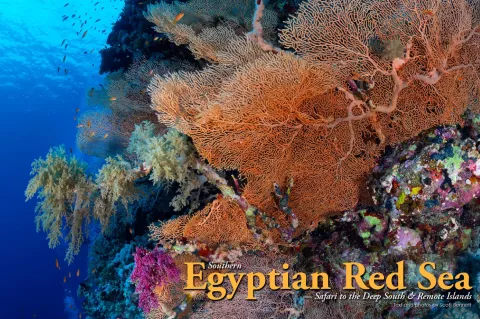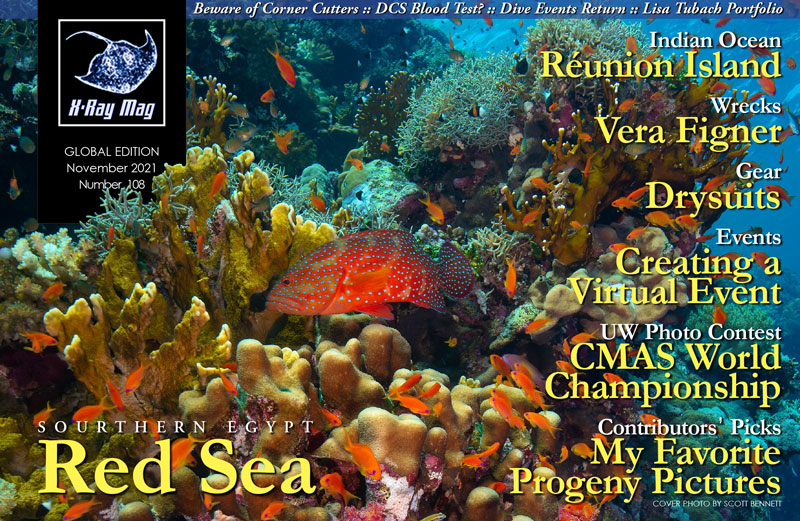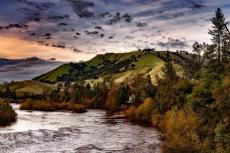“WHAT TOOK ME SO LONG?” I repeatedly asked myself during a recent trip to the Red Sea. One of the globe’s most iconic dive destinations, its spectacular coral gardens, prolific fish life and legendary visibility is beloved by divers the world over. Yet, despite nearly 30 years of diving experience, I somehow had not gotten around to it—definitely on my radar, but inexplicably regulated to the “someday” file.
Contributed by
Every year, my friends Raf and Cisca Jah, who run the African and Oriental Travel Company, charter the MV Nouran from Red Sea Explorers to dive the less-visited parts of the Egyptian Red Sea. The global pandemic halted the 2020 expedition, but this year, they were fortunate enough to be able to lay on the charter—this time to the southernmost point of the Egyptian coast and the deserted islands of Rocky and Zabargad—and they invited me to join them.
I was keen, but as a Canadian, there was a deal-breaker: the Canadian government’s mandatory hotel quarantine for returning travellers. However, when the government announced the lifting of quarantine for vaccinated travellers from mid-July, I immediately sent Raf a two-word text: “I’m in!”
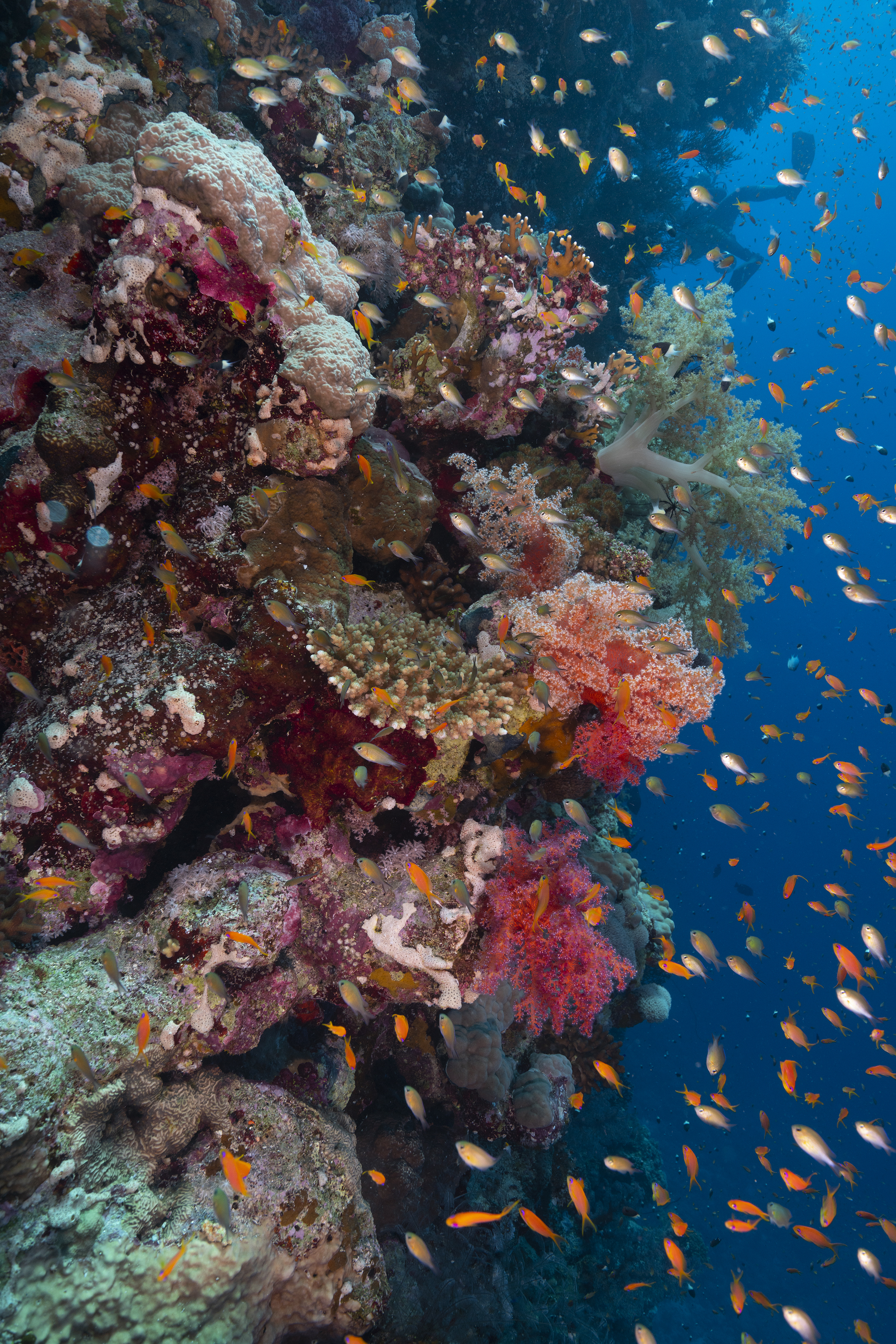
As the world’s northernmost tropical sea, the Red Sea is also one of the saltiest bodies of water on earth, due to scant rainfall and high evaporation rates. An extension of the Indian Ocean, it shares many of the same habitats and marine life but is home to numerous endemic species.
In addition to the liveaboard, an eight-day land extension was also on offer. With the combination of the Covid-19 pandemic and the off-season summer heat, tourist numbers would be significantly lower. The idea of visiting Egypt and not seeing the pyramids was tantamount to sacrilege. How could I refuse?
Departing from Hurghada, our weeklong itinerary would encompass some of the south’s most renowned dive locations, well out of the reach of day-trippers. Remote sites meant fewer boats, reducing the likelihood of diver logjams. The south also maintained the most pristine coral reefs, with a greater abundance of species resilient to climate change. Add sharks and pelagics to the mix, and it was the perfect antidote to Covid blues!
Getting there
My flight route would take me from Toronto to Hurghada, via Istanbul. With flights booked, all that remained was travel insurance and a PCR test. To be safe, I purchased extra Covid insurance, which was not cheap. As a negative PCR test was required 96 hours before flights from Canada to Egypt, I made my appointment 72 hours prior to departure, at a cost of CA$185.00! A pain to be sure, but I was actually going to travel again.
With my flight imminent, I began to ponder possible scenarios. What would travel be like? Would security be extra strict? Would the flight be full? Would wearing a mask for nine hours prove unbearable? Fortunately, all concerns proved unjustified. With Toronto’s airport quieter than usual, check in and security were a breeze. The flight was also full, which was something of a surprise. Even wearing the mask was no big deal, and I slept for most of the flight.
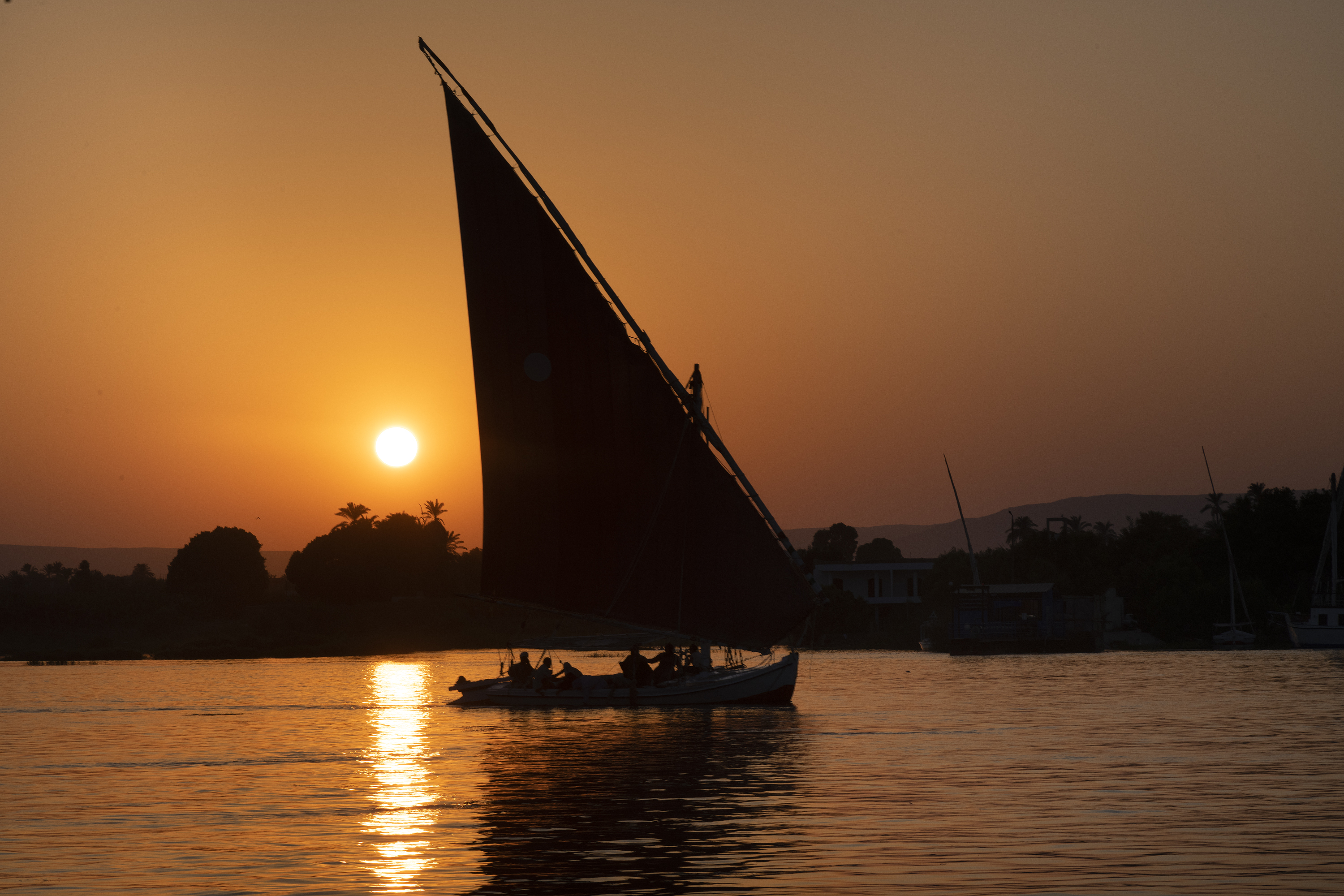
Egyptian contrasts
Istanbul Airport was bustling, a far cry from Toronto’s emptiness. Everything seemed, well, normal. After a bite to eat and a snooze, I headed to the departure gate, where I met up with four other members of our expedition. Along with Raf and Cisca was Paul, a UK expat living in Turkey, and Mike from the United States, who I had travelled with previously. We would meet the rest of the group—four Belgians and another American—in Egypt. After showing our negative test results, we were good to board.
The flight to Hurghada was a brief two hours. After getting through customs and stopping at the duty-free for additional “beverages,” we boarded our shuttle for the Marriot Beach Resort. Despite the long trip, I could not sleep—my mind racing about the adventures to come.
I awoke to a glorious Red Sea sunrise, scarcely believing I was actually here. Then came something unexpected: a hotel breakfast buffet—a downright surreal experience after endless months of Covid protocols back home. Raf had suggested arriving a full day early to rest—just the ticket after the long trip getting here.
Originally, we were set to leave from Port Ghalib, a four-hour drive south, but as the liveaboard boat was already in port, we could leave directly from Hurghada. Meanwhile, Belgians Fien, Wannes, Rutger and Niels had arrived, along with the remaining American Neil. By mid-afternoon, we headed for the marina and were surprised by just how big Hurghada really was. Encompassing a 40km swathe of coastline, it is the second biggest resort area in Egypt after Sharm el Sheikh.
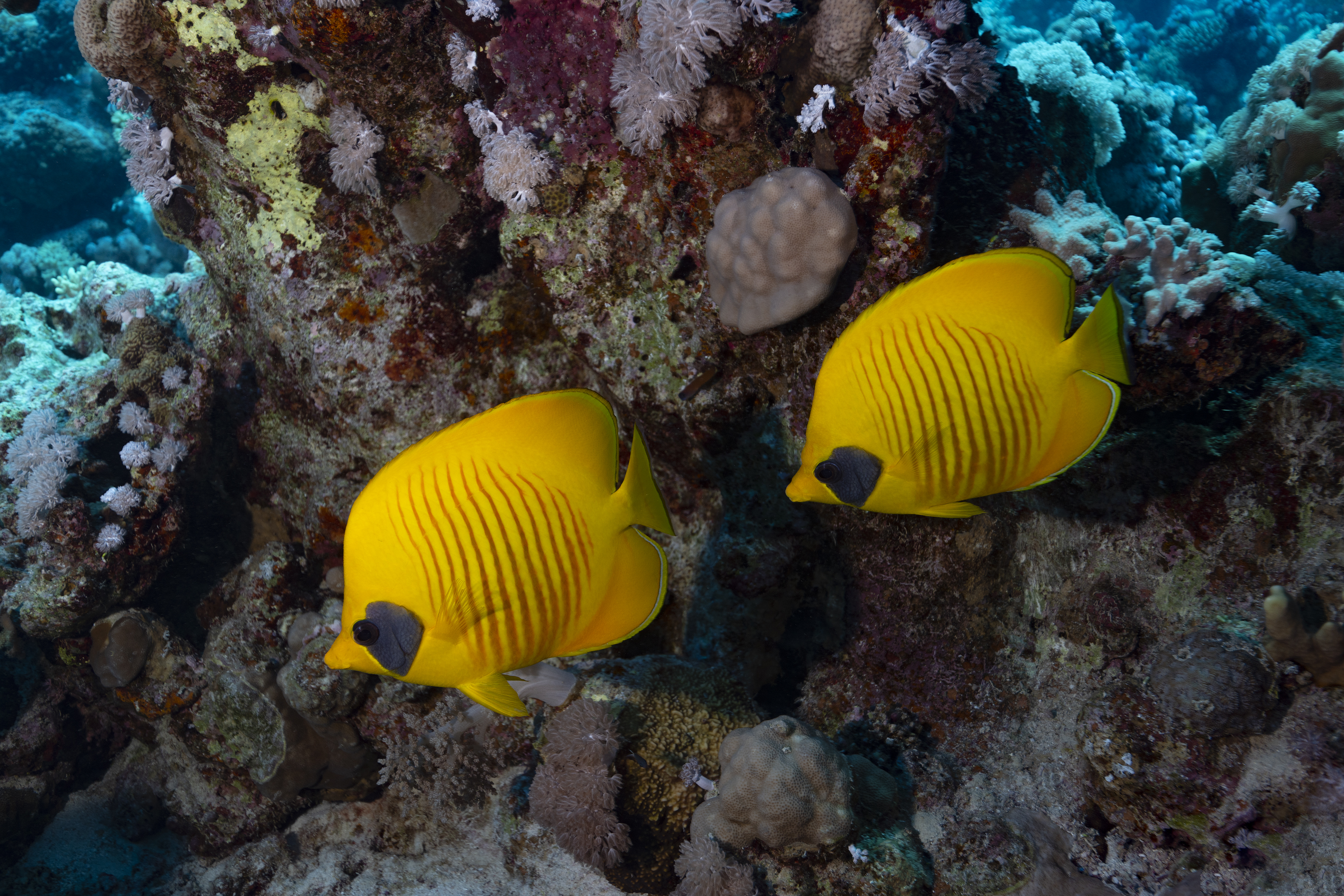
The liveaboard
Waiting for us was the MV Nouran, our home for the next six days. A 36m mahogany-hulled vessel, she catered to 24 guests with 12 cabins and en-suite bathrooms. An air-conditioned lounge and separate dining area offered plenty of outlets for charging, while several outdoor decks offered ample room for post-dive relaxation. No social distancing issues here! The fully equipped dive deck catered to both recreational and technical divers, offering underwater scooters for hire along with an unlimited selection of tanks.
With our departure set for 6:00pm, we had plenty of time to settle in and meet the crew and other guests. On hand were dive guides Le’reyce Josephs from the United Kingdom and Maysara Sayed from Aswan, who gave a briefing before showing us to our cabins. Along with our international group, we had Danish, German and Kuwaiti divers, creating a mini–United Nations. Also joining us were Red Sea Explorers owner Faisal Khaled, his wife Tanya, and two golden retrievers Antar and Batta—all keen divers.
Still in jet-lag’s grasp, I awoke early and grabbed a coffee in the dining room. Stepping outside, it was already hot, with Hurghada’s bustle replaced with silence. On the nearby shore, a cluster of buildings along the coast marked civilisation’s boundary, while beyond, ochre mountains faded into the distant haze. The Red Sea certainly was not named for the colours of its waters; all around, the sea was an astonishing azure, contrasting sharply with the stark coastline. Gazing below, I could discern the bottom. Just how deep was it? Five metres? Twenty metres? I could not wait to find out!
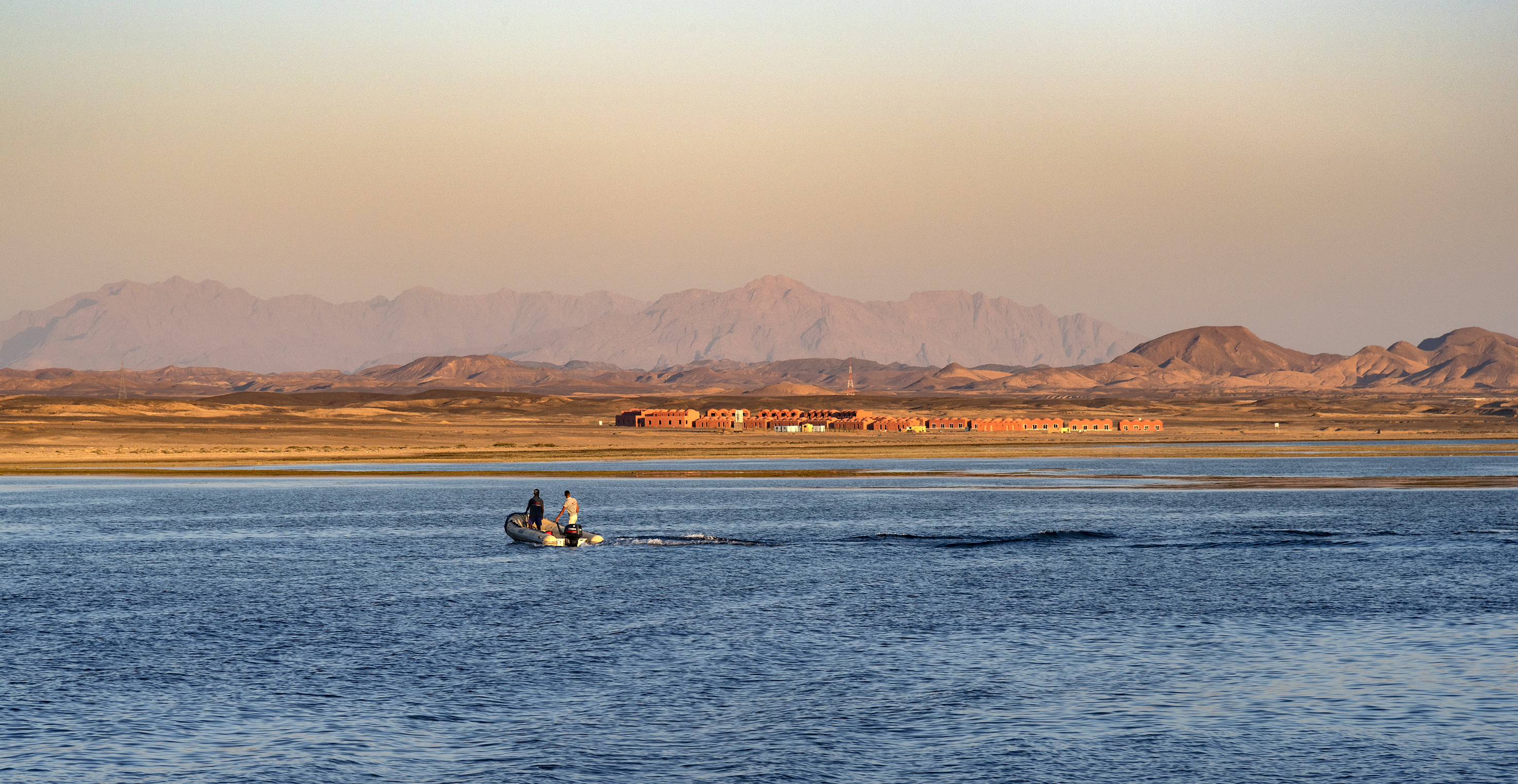
Diving
Ras Torombi. Our first dive at Ras Torombi would be a checkout dive. The 360m-wide bay featured easy conditions and was the usual first stop for southern Red Sea liveaboards. Aside from the reef, an area of seagrass attracted turtles and dugongs, although seeing the latter required luck. As a photographer, diving without a camera on the checkout dive was sheer torment, but as I was renting gear with over two years since my last dive, it was a necessary evil. The only wetsuit in my size was a 5mm, and with the Red Sea’s higher salinity, more weight would be necessary.
After a short zodiac ride, it was time to take the plunge. The water was 31°C (~88°F), and I instantly felt warm. Even despite the proximity to land, visibility was exceptional. From the reef top at 1m, the wall descended to 12m, where the sandy bottom radiated outwards, dotted with numerous coral bommies.
A green sea turtle ascended for a breath (no camera… Arrgh!) as a multitude of reef fish swarmed amongst the corals. Along with recognisable species such as anthias, snappers and damselfish, were Red Sea endemics such as Eritrean butterflyfish and Red Sea bannerfish. Schools of goldstripe goatfish allowed a close approach, and I glimpsed my first Napoleon wrasse (arrgh again…). Despite the lack of a camera, it was a joy to be diving again, and I could not wait to see what the week had in store.
Back on the boat, I faced a dilemma. With the warm water temperature, the wetsuit and excess weights were just too uncomfortable. I wondered how I would manage the week, but it was Le’reyce to the rescue! She suggested wearing a rash guard with my swim trunks. Not only was it extremely comfortable, but I only needed 4kg of weights. Problem solved. Over lunch, I remarked to the Danish couple how impressed I was with the visibility. They both gave me a knowing smile. “It gets better,” said one. Bring it on!
Abu Dabbab. We then moved on to Abu Dabbab, 4km off the mainland and home to extensive coral gardens from 15m down to 4m. The visibility was even better, and I saw a new species that quickly became a photo favourite. Stunningly attired in yellow with a blue patch around the eyes, the masked butterflyfish was another endemic species, usually seen in pairs. At 15m lay the wreck of Heaven, a liveaboard that sank in 2003. Not exactly something one wishes to see on a liveaboard trip…
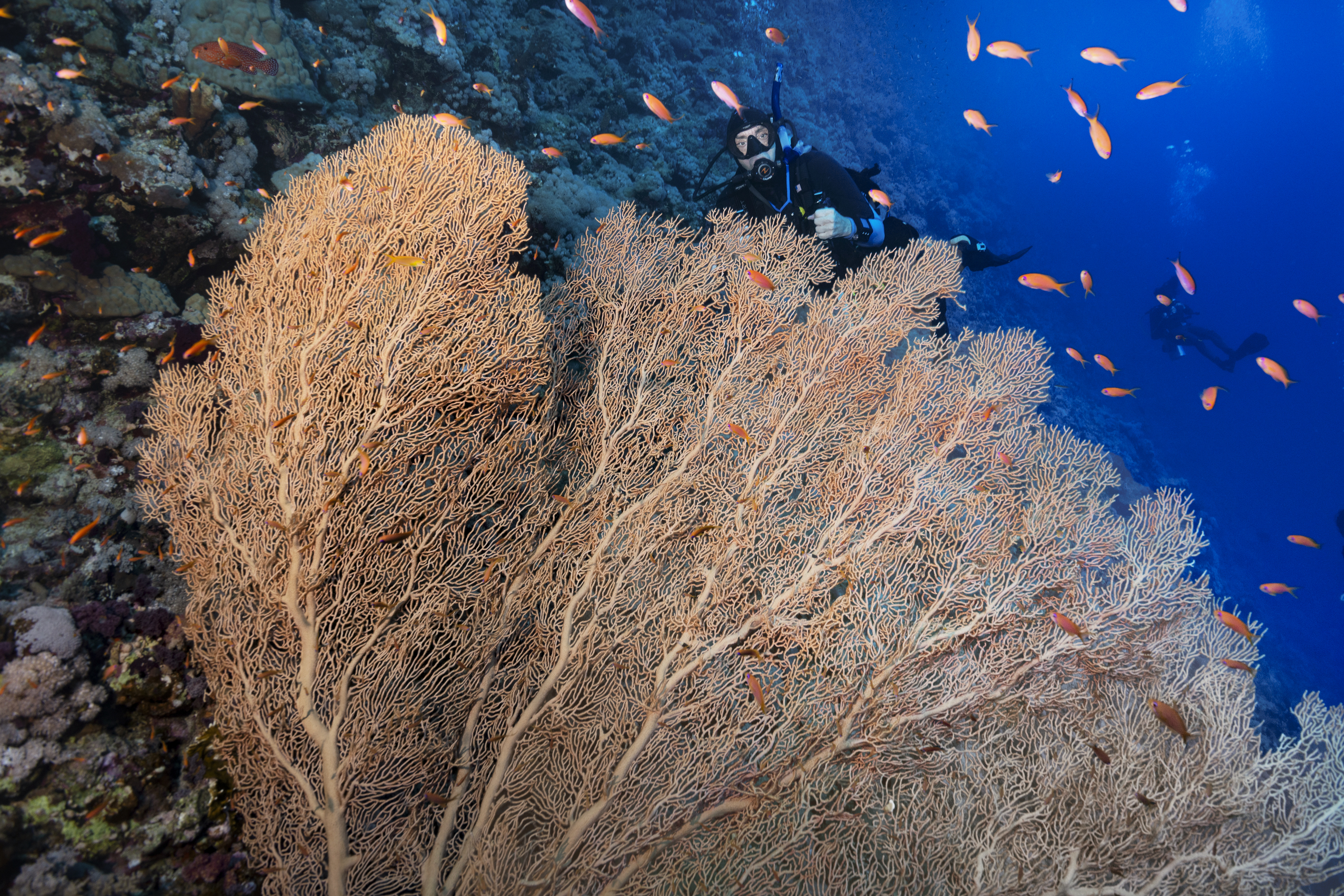
Elphinstone. We finished the day at Elphinstone, regarded as one of the Red Sea’s premier dive locations. At a length of 450m, it featured deeper plateaus to the north and south separated by a massive 300m plateau only 1m deep. Fuelled by nutrient-laden currents, it was also famous for its sharks, with oceanic whitetips being the star attraction.
As seeing the entire site on one dive was impossible, we would concentrate on the southern end. The Nouran was able to anchor to the mooring platform right alongside the reef. During pre-pandemic years, ten or more boats competed for moorings, but we had the entire place to ourselves. Sweet!
Plunging in from the dive deck, it became readily apparent how Elphinstone has earned its renown. The Red Sea is home to more than 200 soft and hard corals, and they all seemed to be here. Acropora was the most common, growing in either plates or branches.
Fungia, soft corals, organ pipe corals and black coral trees all jostled for space, but the fan corals stole the show, with some absolutely massive specimens on display. Mike posed behind one for scale, and it literally dwarfed him. Le’reyce had urged us to keep an eye out to the blue for pelagics, but the kaleidoscopic palette had me spellbound.
Fish life proved equally prolific. Red Sea sailfin tang, masked puffers, emperor and queen angelfish and jewel groupers thronged the reef as anthias amassed in astounding numbers. Visibility was astonishing, easily exceeding 40m and quite possibly reaching 50m! For photographers, it was wide-angle bliss, the clarity ensuring minimal backscatter from my strobes. Sadly, the whitetip sharks remained elusive, but such is the luck of the ocean. Next stop, the Deep South!
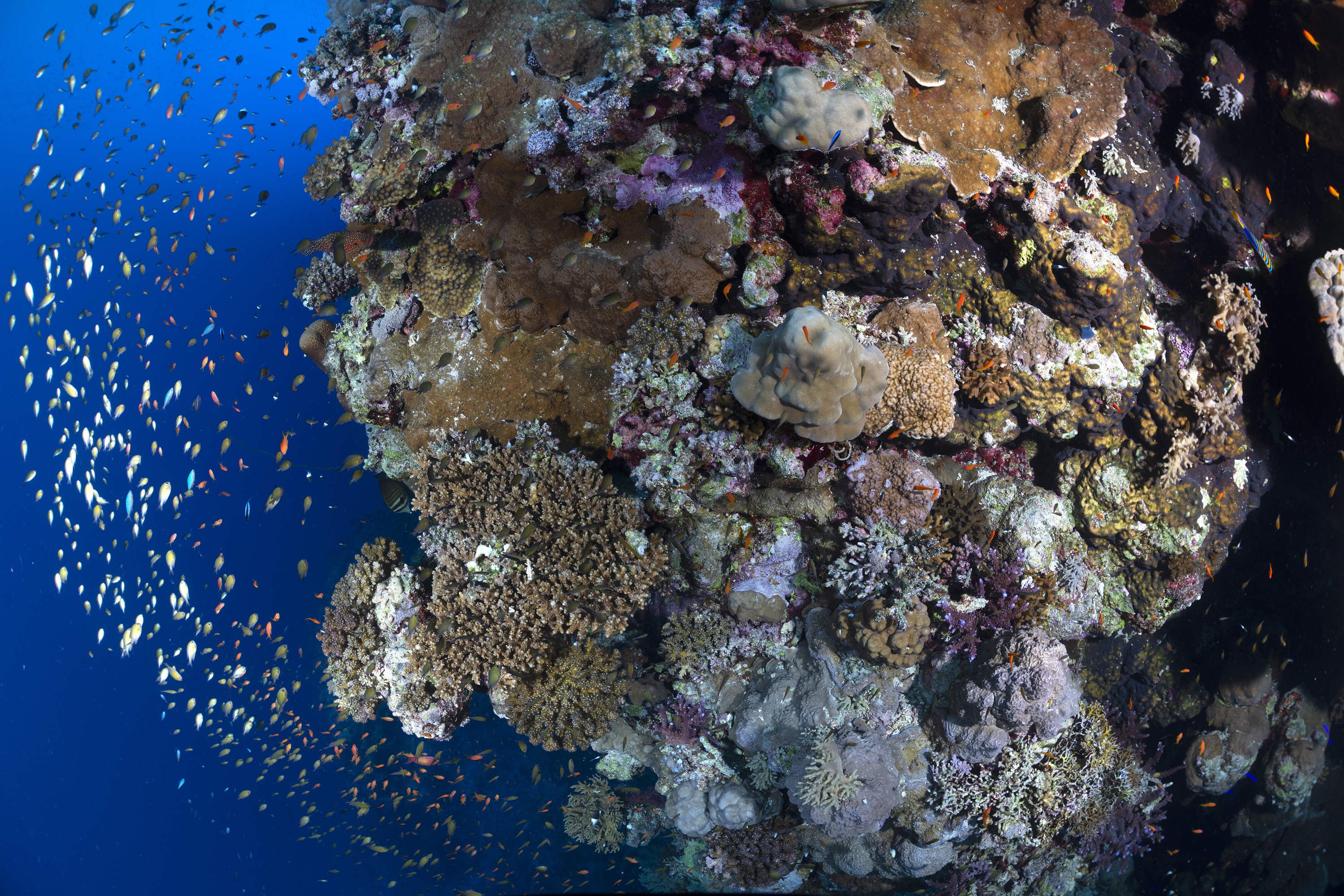
Deep South
Situated south of the Tropic of Cancer, Zabargad and Rocky are the southernmost dived islands in the Egyptian Red Sea. Another 90 miles farther south and we would hit Sudan.
Rocky Island. Our first stop was Rocky Island, a barren slab only 540m across. Below, the scene was a different story. Corals and sponges shrouded the walls as anthias and surgeonfish swirled in dense clouds. Soft corals were radiant, dazzling the eye with hues of violet, magenta and yellow. Far below, between 80 to 110m deep was the wreck of the Maidan, one of the most historic wrecks in the Red Sea, but solely in the realm of technical divers.
A second dive proved even more exhilarating. Red Sea bannerfish, giant squirrelfish, lyretail hogfish and blackspot snapper posed for my camera. Amid walls and overhangs, sunbeams radiated from above, creating a vision of ethereal beauty. The only thing missing was a heavenly choir.
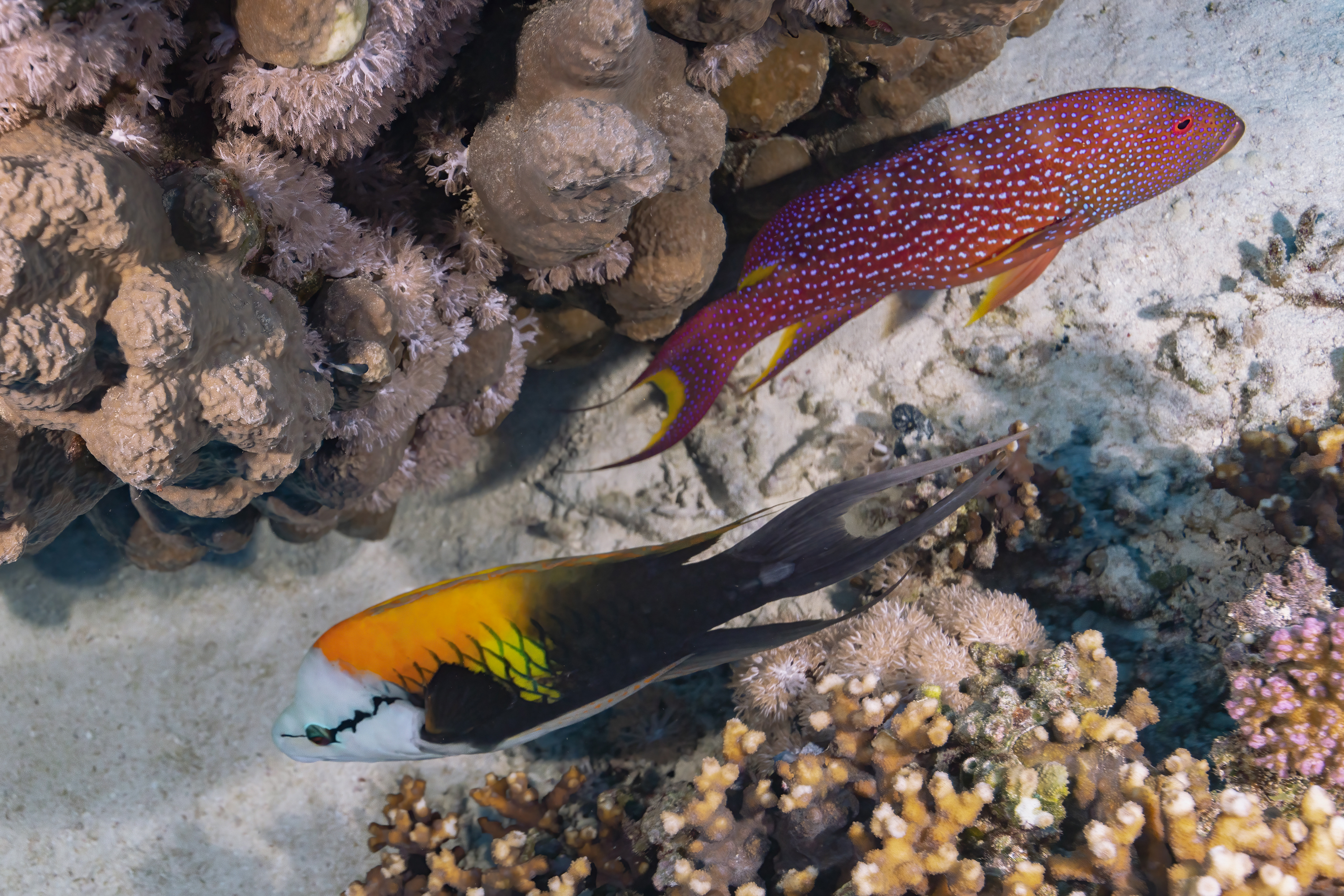
Zabargad Island. After lunch, we finished at Zabargad Island, just 5km to the northwest. Zabargad was the largest island in the Red Sea; its highest point was 800m above sea level. Due to its strategic location, it also served as a base for the Egyptian Armed Forces.
Another superb location, Zabargad offered both wall and shallow diving. Tightly packed hard corals and sponges vied for space as anthias pulsed in staggering numbers. Off the wall, huge tuna patrolled, hoping to snap up unsuspecting prey.
After the final dive, an array of snacks appeared on the outdoor deck, from fresh fruit and cake to kibbeh, a Middle Eastern delicacy with a mixture of bulgur wheat, onions and ground beef. Meals were served buffet style and were some of the best I had ever had on a liveaboard—so much so that my belt would likely need an additional notch at the trip’s conclusion. After dinner, it was sundowner time with gin and topics, as we steamed north to the Fury Shoals.
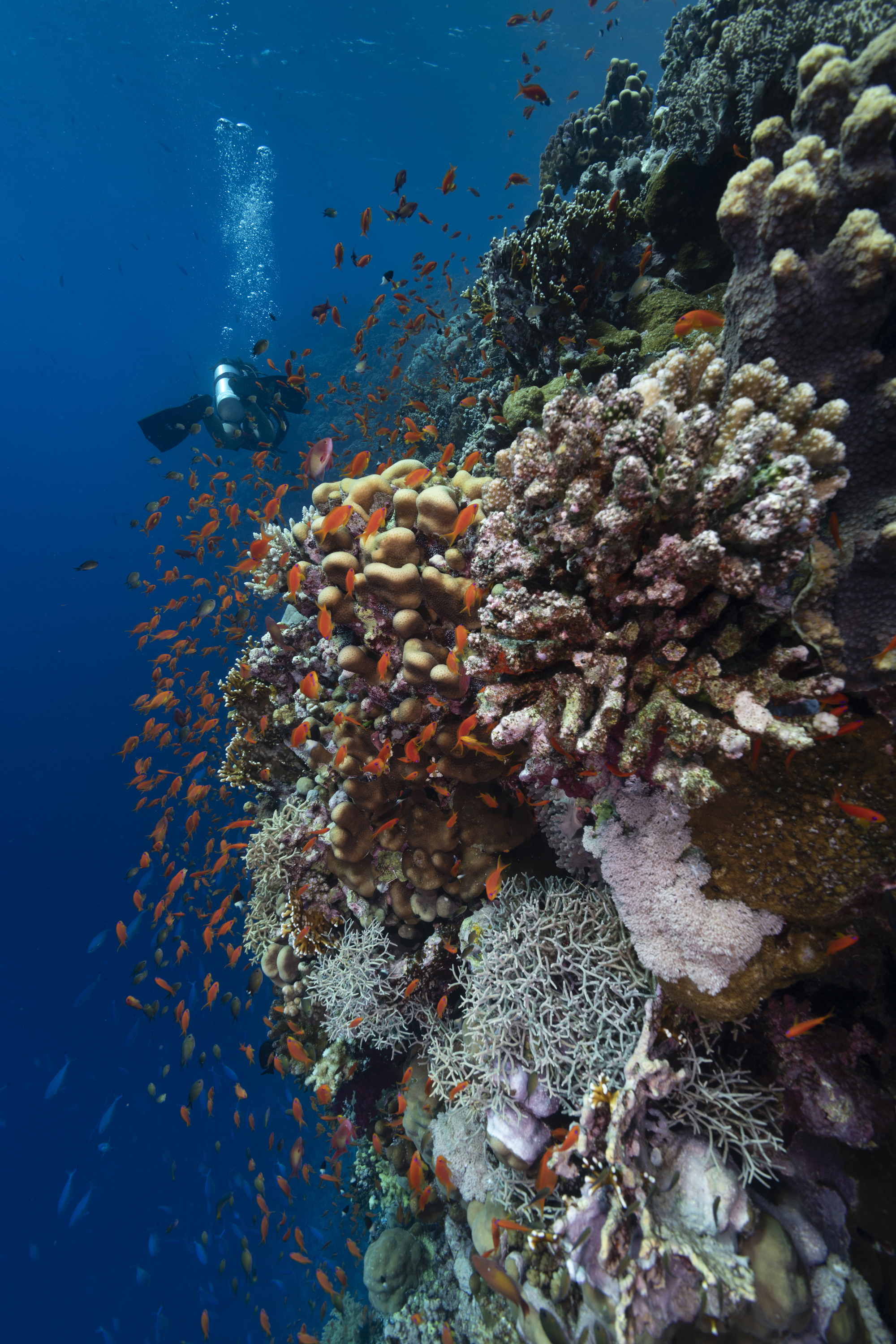
Fury Shoals
Shaab Sataya. With a diameter of 4,700m, Shaab Sataya is the largest reef in the Fury Shoals, where strong currents nourish robust corals and lure the big fish. It is also called “Dolphin House,” due to a resident pod of spinner dolphins. After diving, we attempted to find the dolphins, but they remained elusive.
Shaab Claudio. Undeterred, we moved on to Shaab Claudio, where yet more stunning reefs awaited. The highlight was a small cavern system, with entrances located in the reef wall at 7m and 8m, and an exit at 4m. I wanted to photograph the Belgians swimming through the cavern, so Le’reyce led me in first and indicated a spot to position myself. Great fun!
Shaab Maksour. On the northeastern periphery of the Fury Shoals, Shaab Maksour features a slender 1,500m long reef with steep walls plummeting to a depth of 100m. Finning alongside the wall revealed a remarkable expanse of life. Along with now-familiar faces, Red Sea fusiliers schooled in prolific numbers. Was it my imagination, or were the reefs getting better and better?
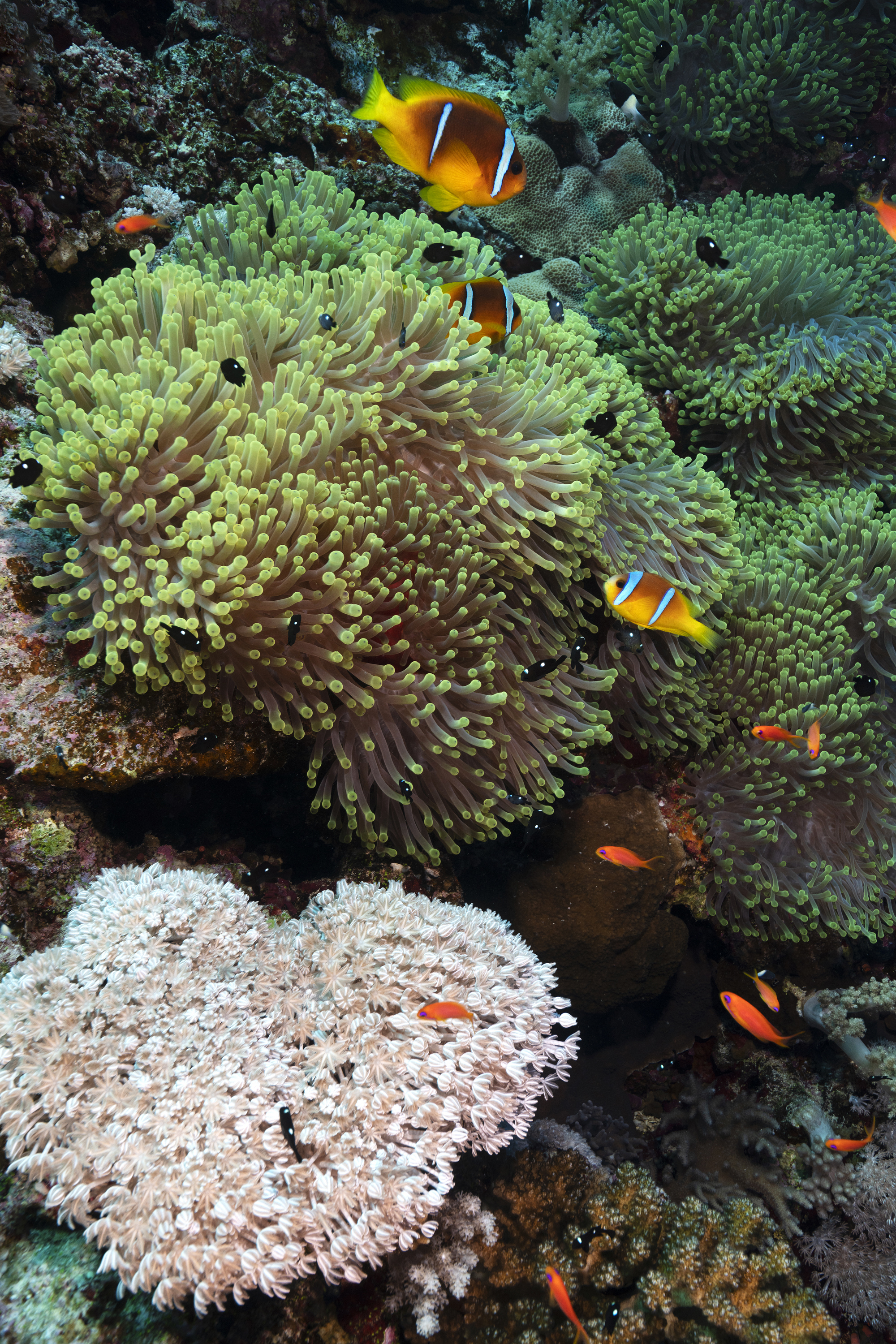
Daedalus Reef. Another overnight voyage brought us to one of the Red Sea’s signature sites. Situated in the middle of the Red Sea, Daedalus Reef ascends from a depth of about 450m to encompass an area 1,070m long and 300m wide.
Encircled by walls, Daedalus Reef descends to 20m and then slopes outwards to 40m before plunging to the depths. Far from any other reefs, its isolation is a pelagic magnet, attracting a plethora of species from far and wide. It is also the final resting place of the Zealot, a loaded cargo ship from the late 1880s, commencing at 75m and plunging to 110m.
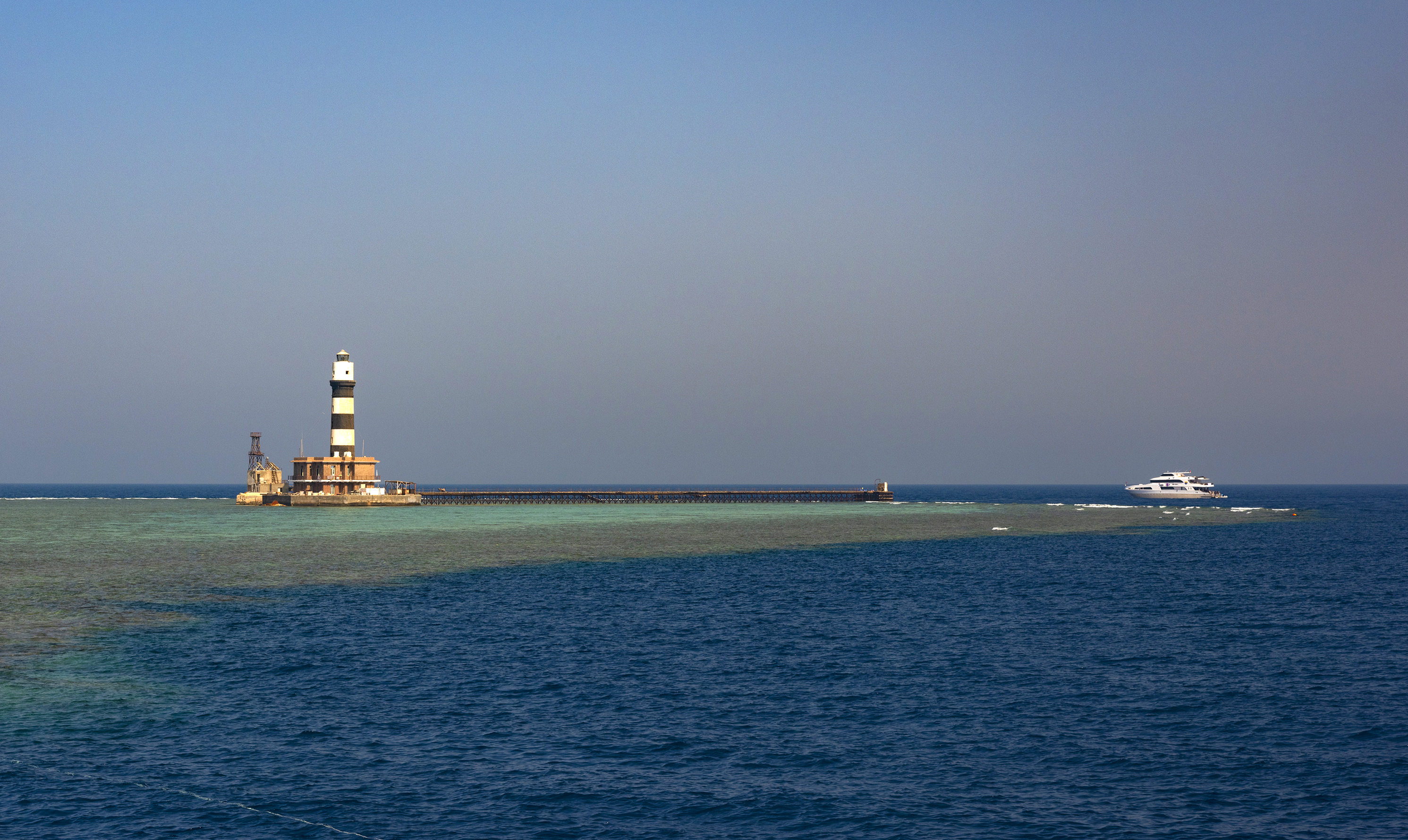
Daedalus Reef Lighthouse. A small artificial island in the centre of the reef hosted a lighthouse. Constructed in 1863, rebuilt in 1931 and renewed in 1993, the 30m structure was painted in black and white horizontal bands. A two-story quarter building was utilised by the Egyptian Coast Guard and Navy.
The star attractions here were the schools of scalloped hammerhead sharks, being the only place in the Red Sea where they can be regularly encountered in large numbers. A late-night arrival ensured an early morning hammerhead dive, so I readied my camera and had an early night, drifting off with visions of hammerheads dancing in my head.
The next morning saw a 5:30 a.m. wakeup call, necessitating several jolts of coffee. Along with the four Belgians and Le’reyce, I boarded the zodiac for the brief trip to our entry spot. “We need to do a negative entry due to the surface currents,” explained Le’reyce. I was not happy doing this with a camera but figured there was no choice. Grasping it firmly to my chest, I did a backward roll and immediately started my descent.
At 26m, Le’reyce signalled to us to stop as she scanned in all directions. I had been in this exact scenario on some dive trips in the past. “Sure,” I thought. “We will sit here for 15 minutes, see nothing and then head back to the reef.” And how wrong I was! Within five minutes, she gestured excitedly: A hammerhead was heading right in my direction! Incredulously, it came to within 3m, checked me out and promptly vanished. I managed to fire off a few shots, although I had been instructed not to use strobes. Amazing!
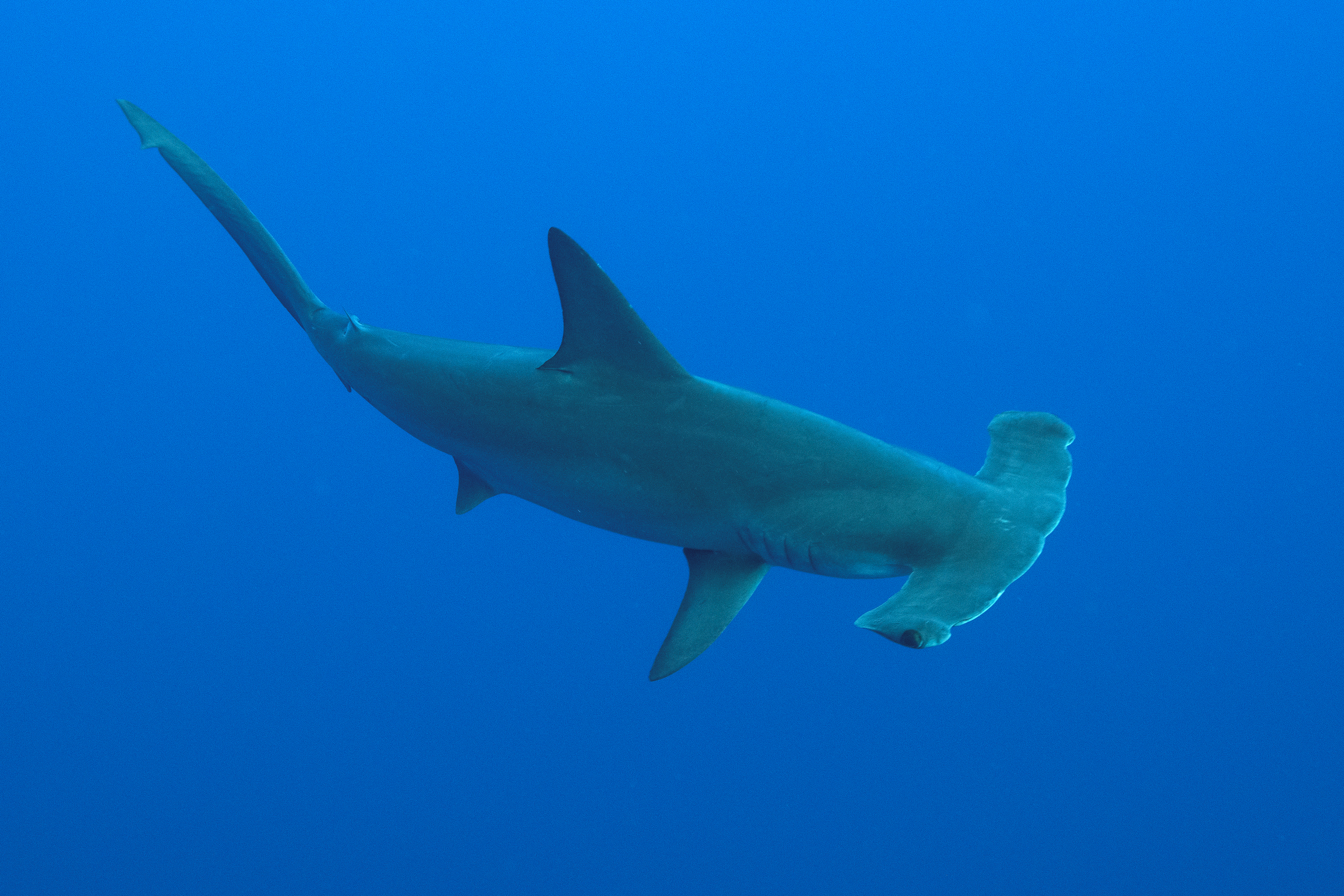
Strobe mishap
Heading back to the shallows, my elation turned to anguish. While attempting a shot of the reef, my strobes would not fire. In despair, I realised the flash sync cord had popped out during my backwards roll. Then, to add insult to injury, a huge Napoleon wrasse appeared just an arm’s length away. Undaunted, I photographed it and hoped for the best. Later, I was able to adjust the images back to their natural colour. Thanks, Photoshop!
Back on board, I explained my predicament to Faisal, who instructed me to rinse the sync cord and camera bulkhead with fresh water, then vinegar and allow it to dry. The housing was okay, but the sync cord was damaged. Fortunately, I had spare strobes and cords. Note to self: no more back rolls holding a camera! That evening, Faisal announced we would remain at Daedalus for a second day, allowing the chance to make up for missed opportunities.
Sadly, I never got another up-close Napoleon encounter, but there was plenty more to photograph. Porites corals formed massive colonies, as Red Sea bannerfish, common bigeye, slingjaw wrasse, orangespine unicornfish and two-banded anemonefish swarmed in abundance. We even spotted the lone hammerhead shark again, as it patrolled the blue. With waters so warm, the school of hammerheads remained in the cooler depths.
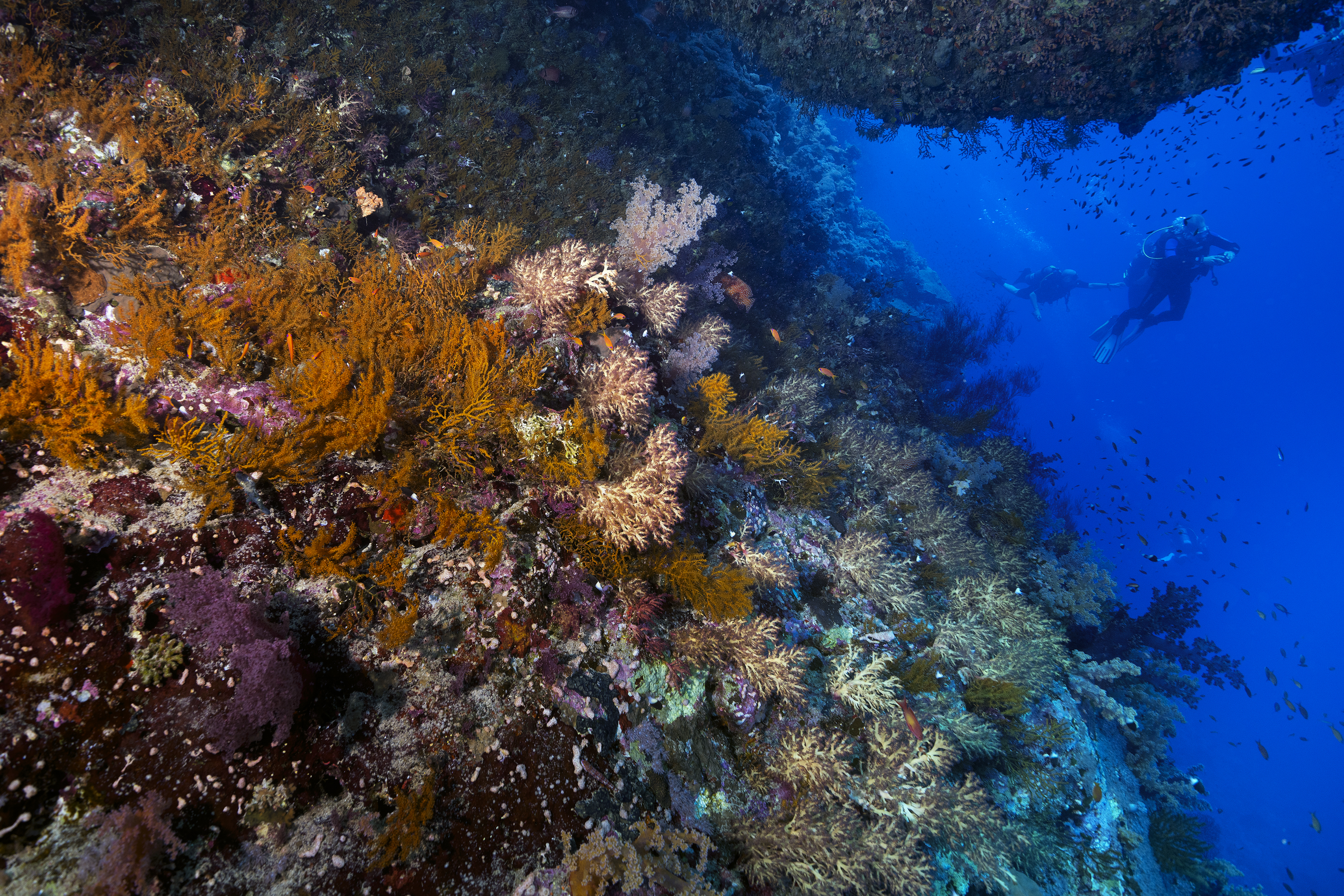
Back north
After two wonderful days, it was time to head back north. After another overnight passage, our last diving day saw return visits to Elphinstone and Ras Torombi.
Elphinstone (revisited). At Elphinstone (my trip favourite), I switched to the fisheye lens, and with Maysara as our guide, explored the reef’s northern end. The trifecta of gin-clear visibility, superb light and an explosion of fish life sent my camera into overdrive. A school of blue-fin trevally pulsed off the wall as lyretail grouper, common lionfish, scribbled filefish, freckled hawkfish and emperor angelfish mingled amongst the omnipresent anthias. A giant moray erupted from a crevice, swimming above the reef top before vanishing around the corner. Le’reyce motioned it was time to head back. “Five more minutes?” pleaded my expression.
Ras Torombi (revisited). At Ras Torombi, I played hide-and-seek with a Red Sea boxfish, while the sandy bottom was alive with blue-spotted stingrays. Heading for the seagrass, we hoped for a glimpse of turtles or dugong, but both remained ever elusive. Sadly, this would be our final dive, as it was time to head back north to Hurghada. On our final night, we enjoyed a selection of photos and videos by all the participants on the lounge TV. I was thrilled to see the Danes had a video of my hammerhead encounter.
Arriving in port before breakfast, we had plenty of time to finish packing and bid farewell to Faisal and his wonderful crew. We also said goodbye to Niels and Neil, who would not be joining us on the land tour. Even before stepping off the boat, I knew the Red Sea was a place I would return to. But onward now to new adventures!
Land tour
Setting out on the five-hour journey to Luxor, the scenery epitomised desolation, with parched plains strewn with peaks. Approaching the city of Qena, things changed. Subtly at first, a tree appeared, then two… then a field, followed by another. Before long, an explosion of fertility meant one thing: The Nile was near. Passing verdant fields of corn and sugar cane, roadside stalls groaned beneath immense melons and mangoes, as egrets gathered along numerous canals. However, the fertility was deceiving, extending only 6km on either side of the river.
We soon arrived in Luxor and had our first view of the Nile, with our hotel enjoying a riverside view. Waiting for us was Mr. Ahmed, who would be our guide from Luxor to Aswan. To ease the following day’s itinerary, Raf and Cisca suggested we visit Luxor Temple later in the afternoon.
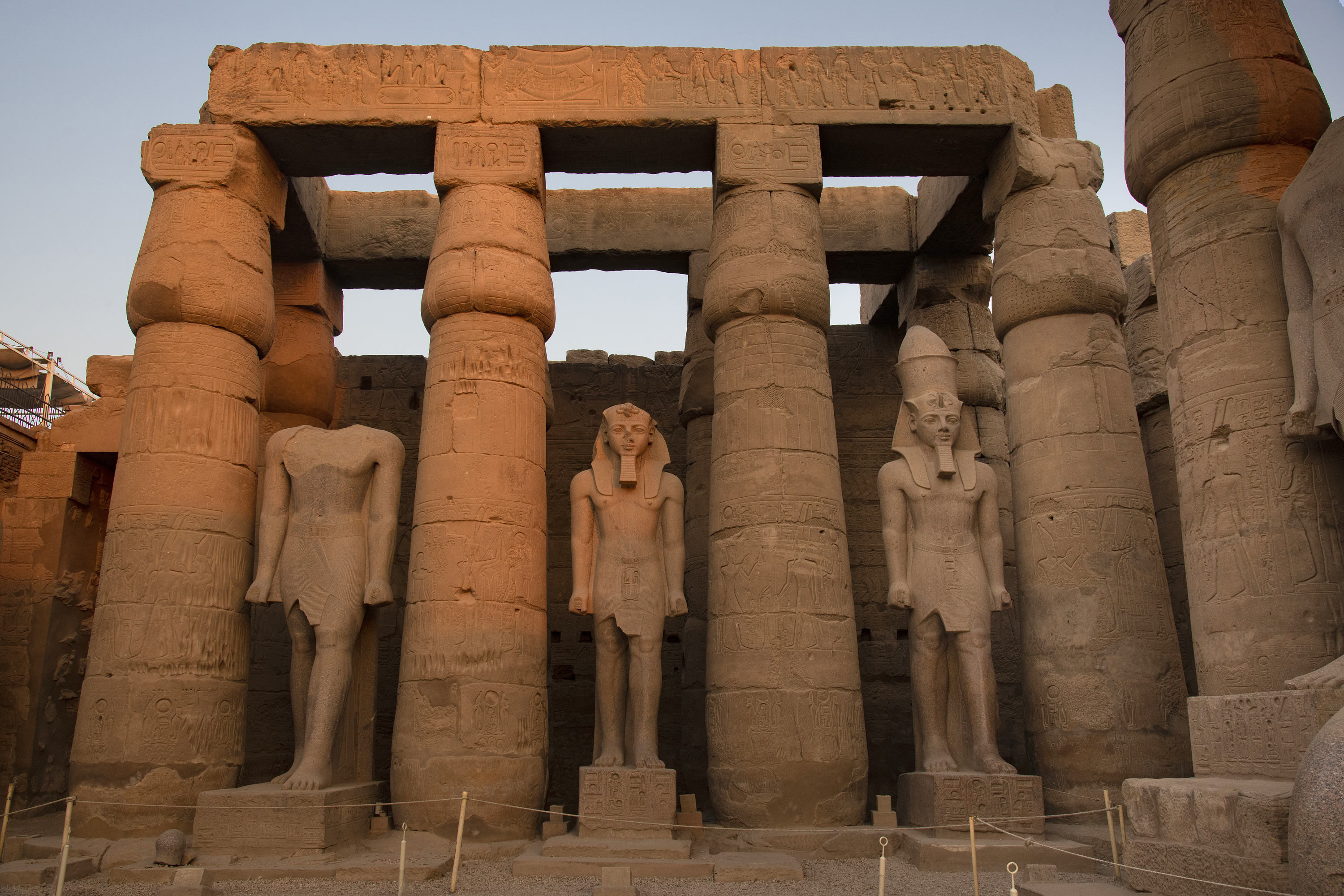
Luxor Temple. A short bus ride away, the temple was an impressive sight, its entrance guarded by immense statues of the pharaohs and a towering obelisk. Constructed in approximately 1400 BCE, a majestic colonnade of pillars led to an expansive court with halls and chambers beyond. With walls burnished by the setting sun, we had the run of the place, with Raf and I photographing to our hearts’ content. As twilight deepened, floodlights lit the complex, perfecting the magical aura.
Valley of the Kings
I awoke early to admire the Nile from my balcony, the stillness punctuated by the morning call to prayer. The calm was fleeting, as the day would soon prove intense. Our first stop was the Valley of the Kings but getting there by road required a detour to the Nile Bridge, 8km south of town.
Colossi of Memnon. Crossing to the West Bank, we stopped at the Colossi of Memnon, twin seated statues of immense proportions. Crumbling yet imposing, they marked an abrupt boundary where greenery ended, and desert began. Here, the road ascended to the Valley of the Kings, one of Egypt’s most renowned archaeological attractions.
New Kingdom tombs
From the 16th to 11th century BCE, rock-cut tombs were excavated for the pharaohs and powerful nobles of the New Kingdom. Comprising of at least 63 tombs, the valley has been a tourism site throughout antiquity, especially during Roman times. It was mind-boggling to imagine how many people had passed here before us.
First, we had a major obstacle: a tourist bazaar rife with determined vendors. My strategy? Look straight ahead and walk FAST. After getting our tickets (one general admission ticket covering three tombs, a second for two extra tombs, plus a photography permit), we boarded a tram to the site. With the mercury already hitting 46°C (~115°F), walking was not an enticing option.
We visited a total of five tombs of varying sizes and depths, the usual design featuring an inclined corridor descending through halls to a burial chamber.
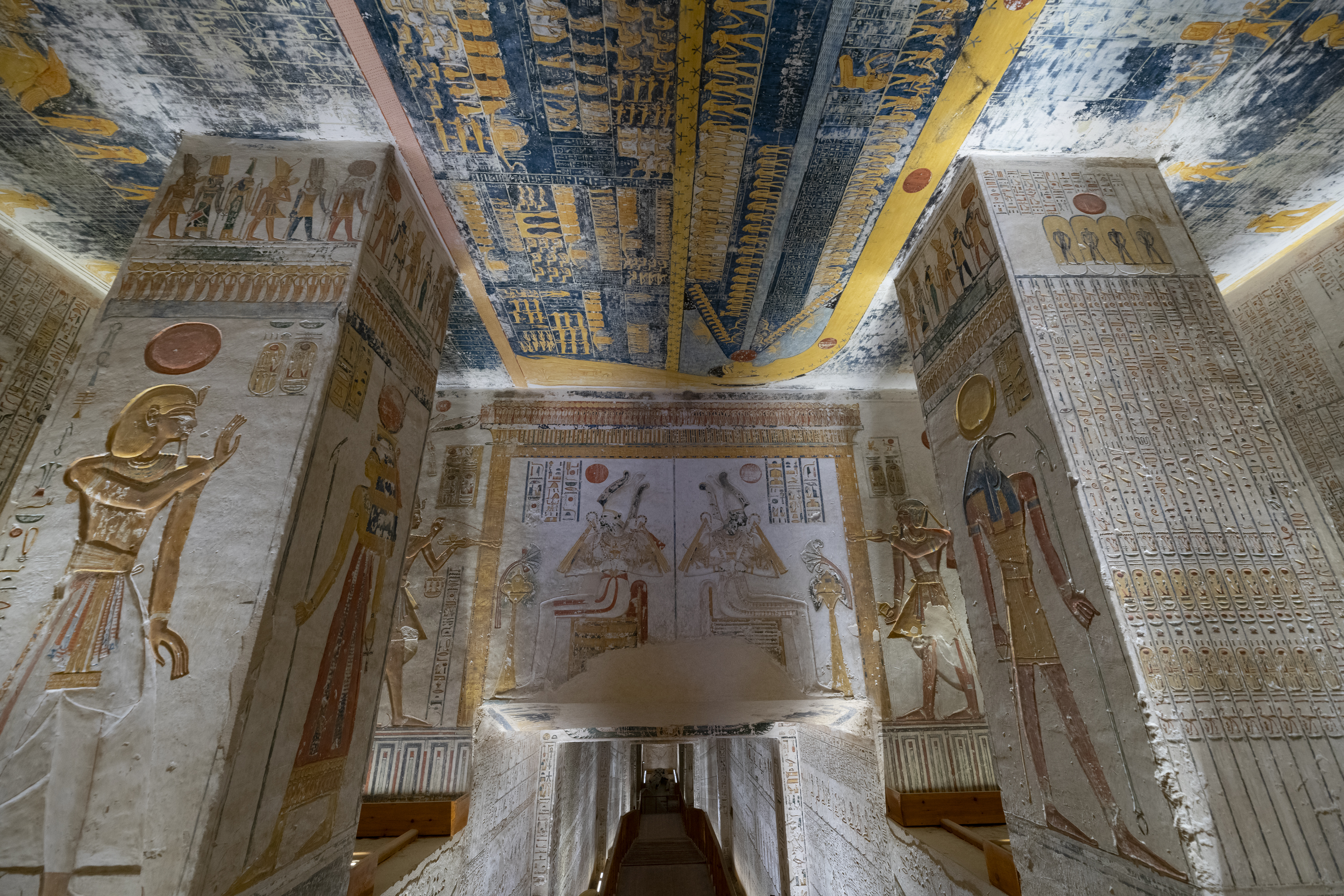
Tomb KV9. For me, the most impressive was Tomb KV9. Originally built for Pharaoh Ramesses VI (ca. 1145 BCE), his uncle Ramesses V later reused the tomb for himself. The decorations were astonishing, with much of the original colour still present.
Tutankhamun’s tomb. The one tomb banning photography was Tutankhamun’s; yet curiously, it was the least impressive. Apart from Tutankhamun’s mummy, the tomb was empty, its contents sent to the Cairo Museum long ago. According to Mr. Ahmed, up to 10,000 visitors a day throng the site during peak months, yet we counted less than 100. Exploring freely, I could scarcely imagine the oppressive hubbub of a jam-packed tomb.
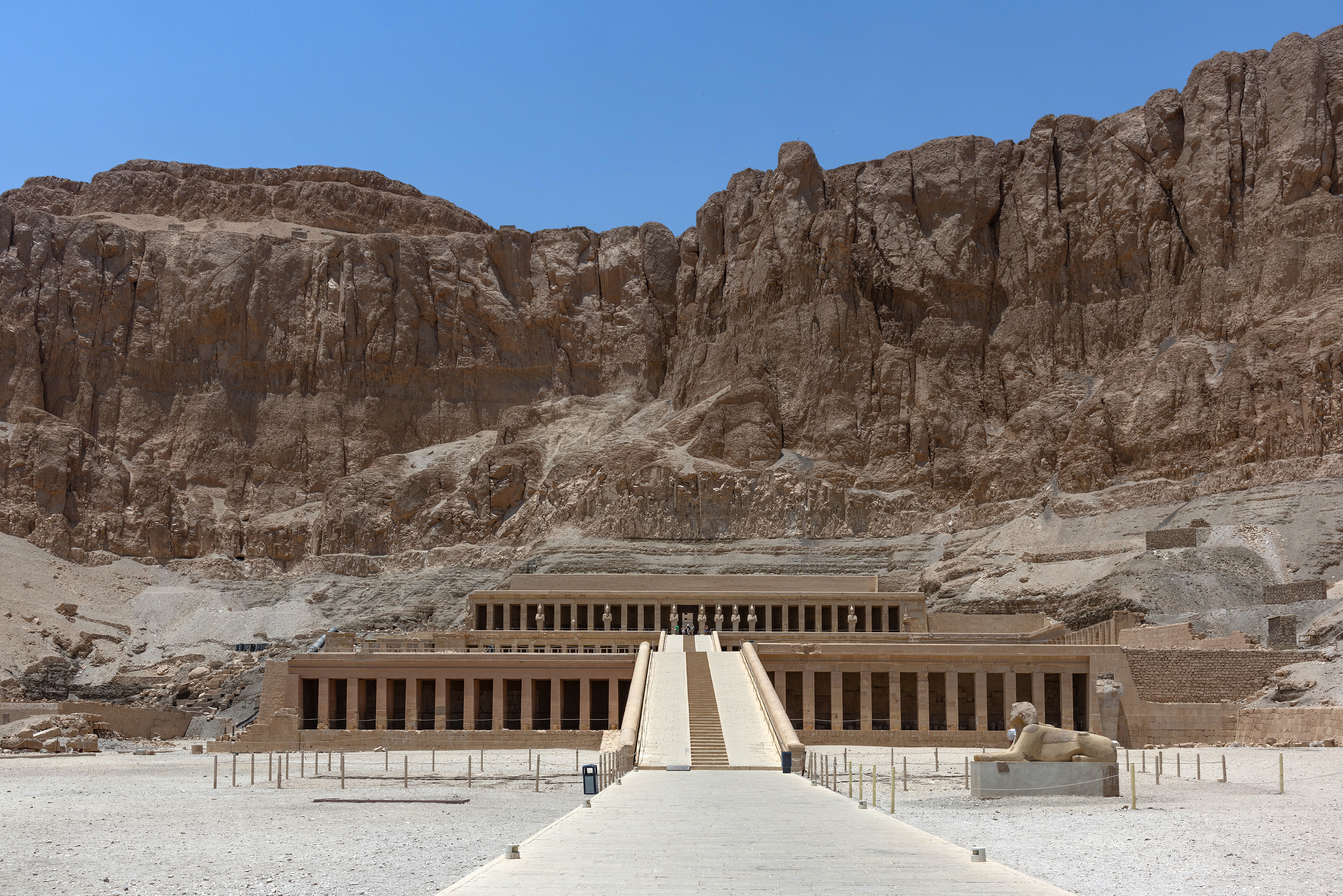
Mortuary Temple of Hatshepsut. Leaving the valley, we finished at the Mortuary Temple of Hatshepsut (ca. 1507 BCE), dramatically positioned beneath sheer cliffs. Dedicated to Egypt’s most infamous female pharaoh, its expansive stepped platforms, pillared entryways, and colourful reliefs create one of Egypt’s architectural masterpieces. In contrast, the politics of her ascension and reign would be fully at home on a TV reality show.
Rather than endure the 40-minute drive back to Luxor, Mr. Ahmed suggested we take a boat, as our hotel was in sight across the Nile. We crossed on board the Titanic (seriously, you cannot make these things up), with an eclectic assembly of toys and dolls suspended from its ceiling, as a matted plush bear sat alongside the captain like a first mate.
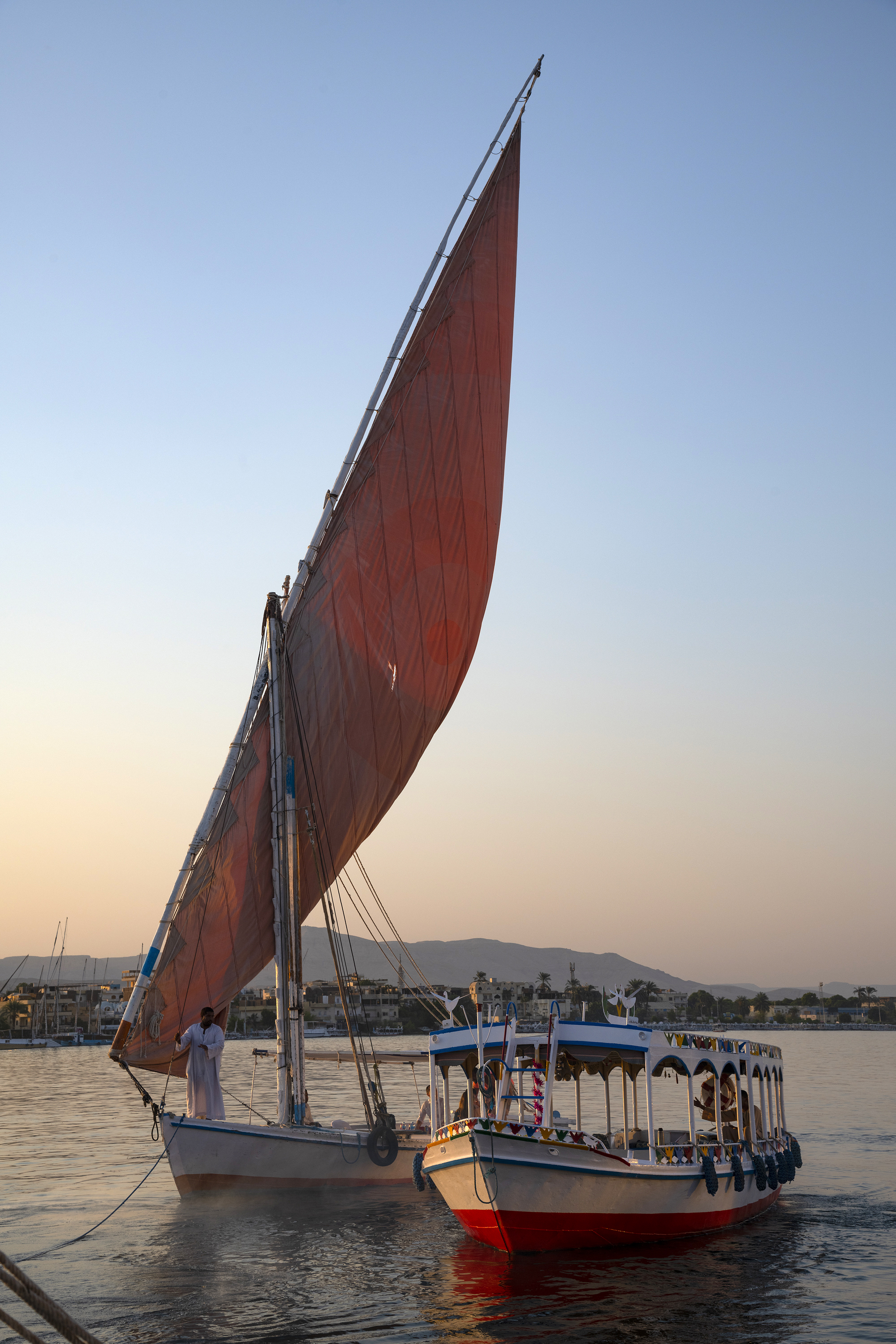
Nile cruise
Later, we were back on the Nile for a sunset cruise. Along the riverfront, a flotilla of boats eagerly awaited customers with names like Daydream, 2 Queen Mary (two of those), Horus and Donald Duck to name a few. Ours was named Beautiful Dreams, the ideal venue for a sundowner cruise. Feluccas, with their distinctive sails catching the breeze, drifted by as Luxor twinkled in the waning light. Coming ashore on a sandbar, we watched the Nile glow molten orange, mirrored by floodlights illuminating the Temple of Hatshepsut. Sheer magic!
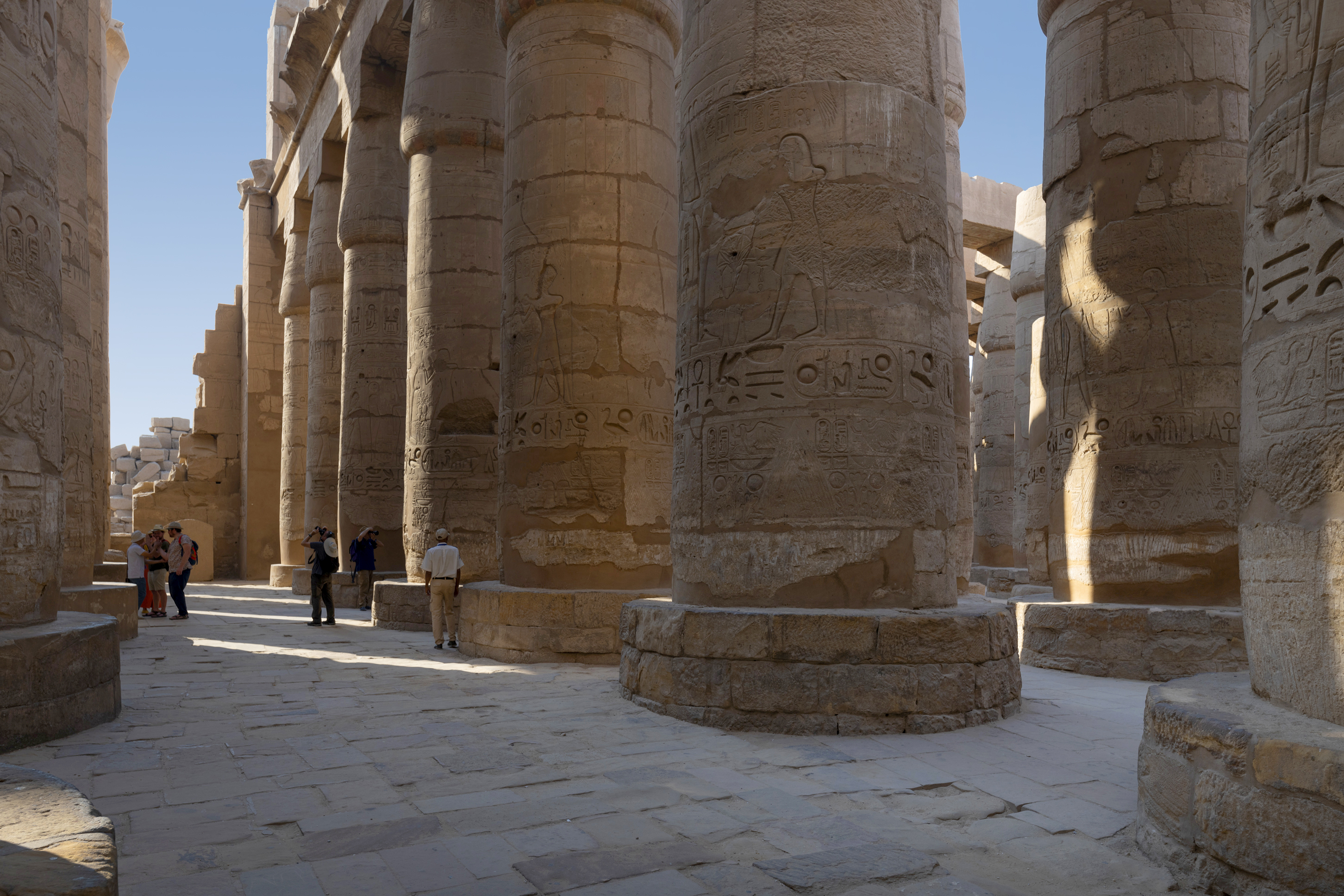
Karnak
The next morning, we concluded with a visit to Karnak (built ca. 2000-30 BCE), the largest temple complex of the ancient world. Once again, an early arrival meant zero crowds. With its entrance bordered by an avenue of sphinxes, the site was overwhelming. The gigantic pillars, towering columns, chapels, and an obelisk towering nearly 30m left one grasping for adjectives. The Great Hypostyle Hall alone was large enough to encompass the cathedral of Notre-Dame.
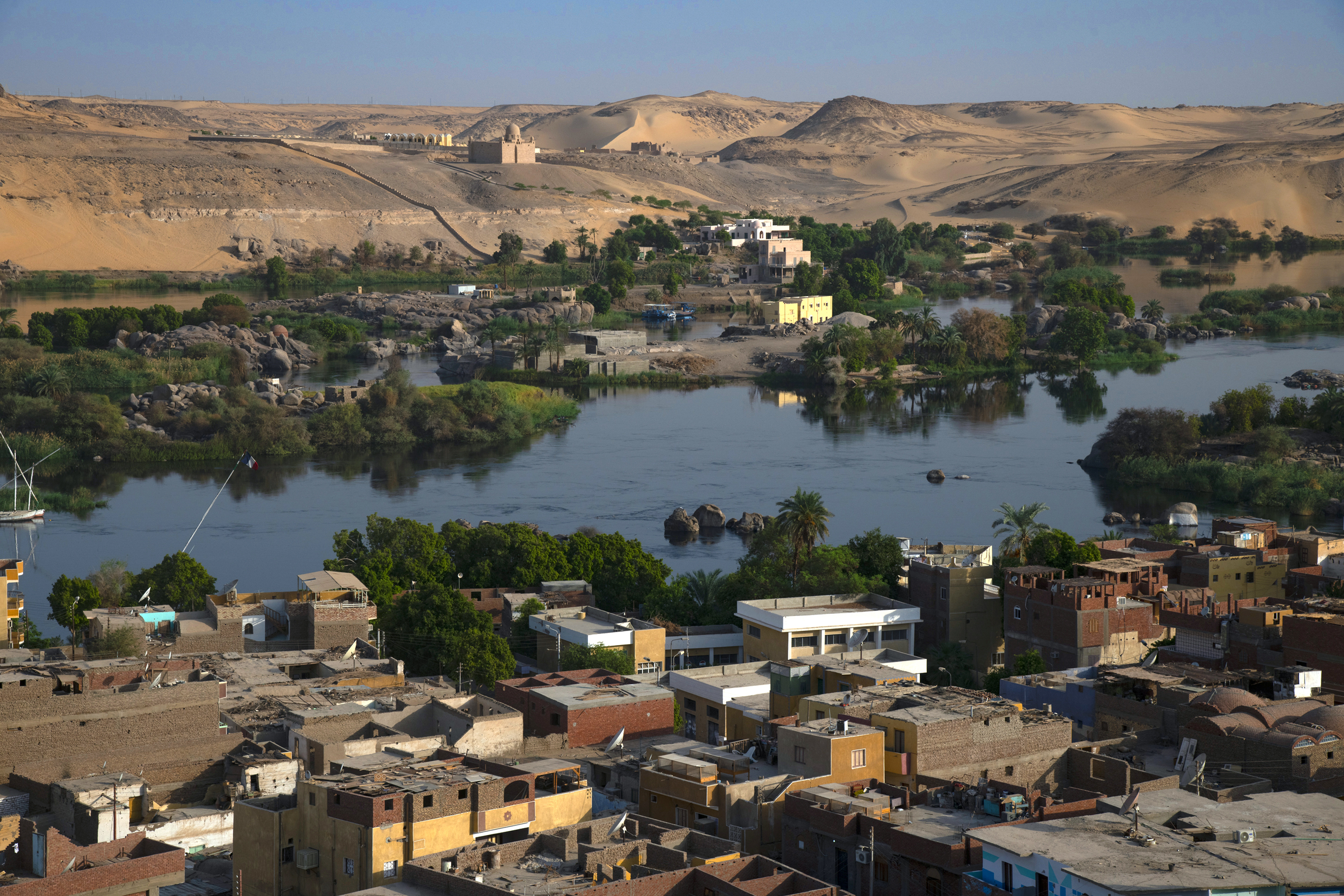
Aswan
Senses pummelled, we set out on the five-hour drive south to Aswan for a three-night stay. If Luxor’s riverfront location was impressive, Aswan was magnificent! Here, a series of granite islands formed the Nile’s first cataract, forming a barrier for the big cruise liners heading south. Perched on a high hilltop, our hotel offered stunning views of the city, river and surrounding desert. Arriving in the late afternoon, the light was sublime, and I made a beeline for the rooftop terrace to get some photos.
Unfinished Obelisk. The next day featured a packed itinerary. We first stopped at the quarry to see the over-3,500-year-old unfinished obelisk, which, if completed, would have been the world’s tallest, at 42m. After many months of work, the granite cracked before being dislodged from the bedrock. To say the pharaoh was displeased is likely an understatement.
Aswan High Dam. We then moved on to Egypt’s modern engineering feat, the Aswan High Dam. Constructed between 1960 and 1970 to control flooding, provide water for irrigation and generate hydroelectricity, it also created Lake Nasser, one of the world’s largest artificial lakes. However, its creation impacted our next stop, the temple complex of Philae.
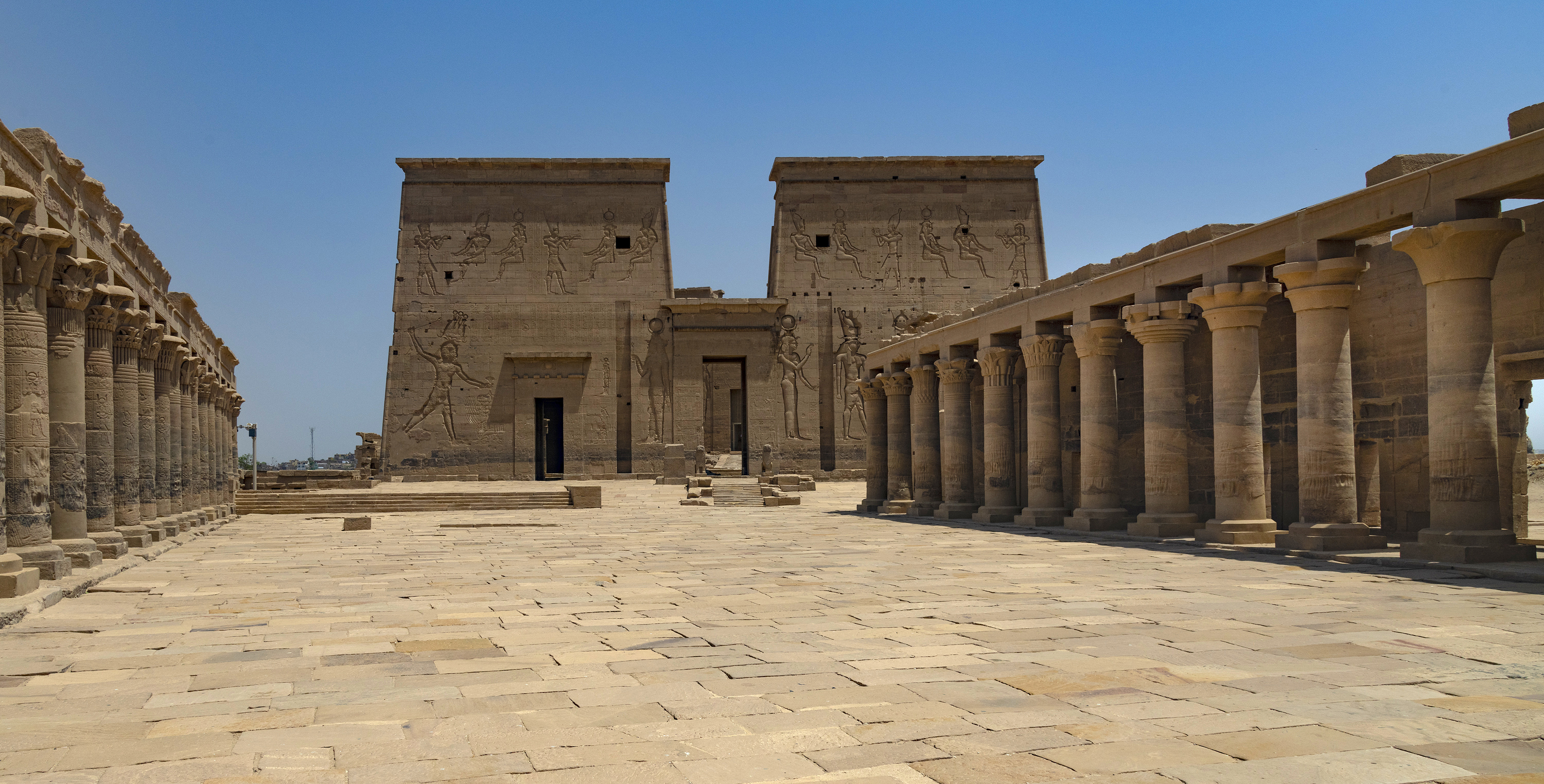
Philae Temple Complex. Originally established near the Nile’s First Cataract, the entire site was dismantled and moved to its current location on Agilika Island before the dam’s completion. A centre for the cult of Isis, Philae’s temples were revered from the Pharaonic Era right through to Byzantine times, with each ruler making their own additions. Once again, we had the entire site to ourselves. In fact, there were more cats in the main temple than people!
Aswan market. Back in Aswan, I had arranged for Mr. Ahmed to take me to a local market. At first, many stalls seemed closed, but venturing farther, activity intensified. At a bakery, I sampled delicious flatbread, while another offered fresh dates. Cakes and sweets tempted passers-by, along with sacks of hibiscus flowers, Hello Kitty carpets, immense kitchen pans, and everything in-between. Venders were genuinely welcoming, with many posing for photos. Without a tourist in sight, it was a wonderful way to spend two hours.
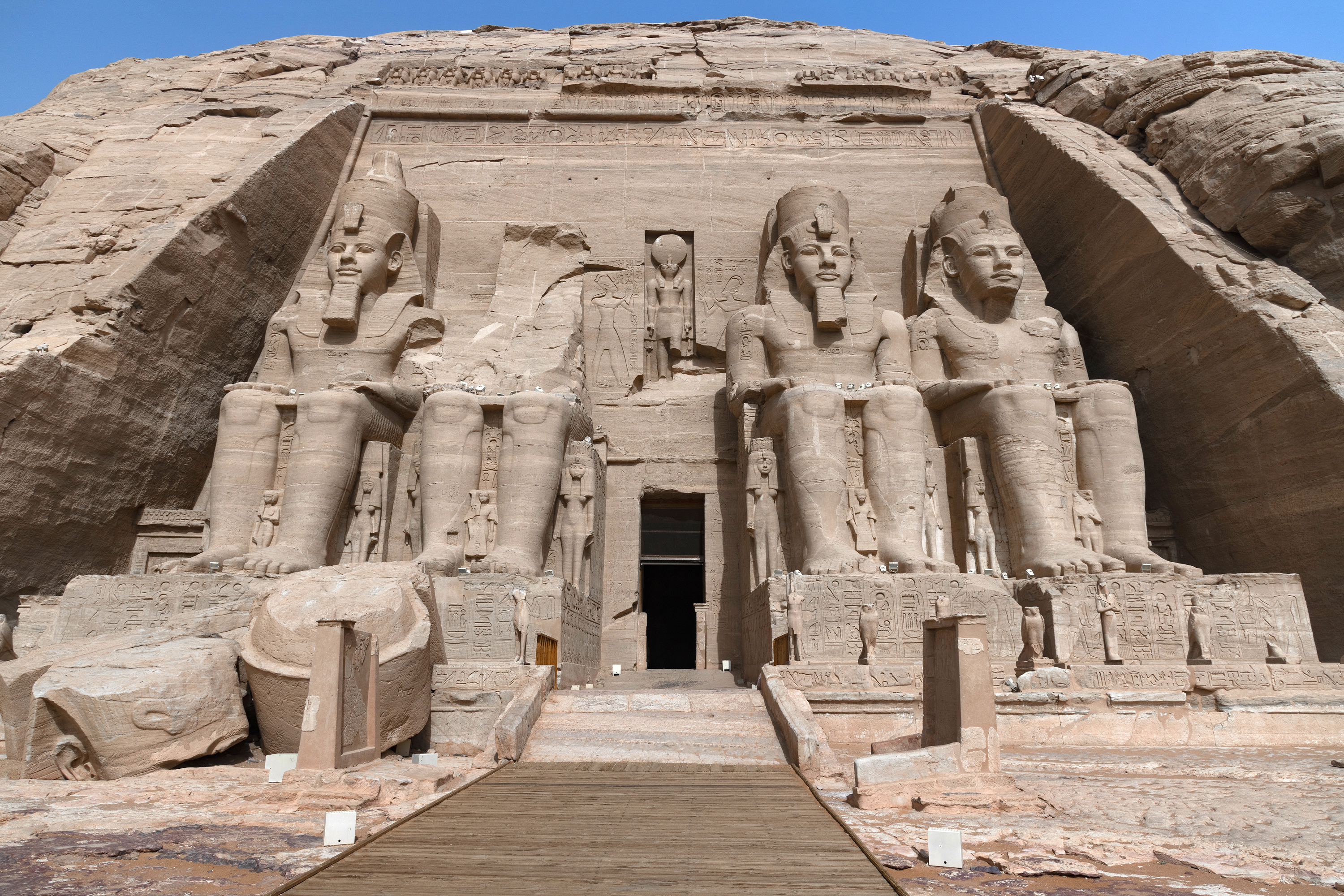
Abu Simbel
The next day would take us to the place most impacted by the High Dam, necessitating an engineering feat of epic proportions. Abu Simbel was a place I had long desired to see, having read about it way back in public school. However, getting there was no minor jaunt. A three-and-a-half-hour trip each way demanded a wakeup call, as Raf put it, “at stupid o’clock.”
We first had to reach the Desert Highway checkpoint for its 5:00 a.m. opening (driving is not permitted at night). Gates open, we motored on, not stopping until we reached our destination. Although a pair of minibuses had already arrived, the parking lot was empty. Almost. As the bus door opened, eager vendors flashed t-shirts and trinkets, despite it being only 8:15 a.m.
Before entering, we viewed an exhibit chronicling the entire relocation process. Between 1964 and 1968, every section of the temple had to be cut, dismantled and reassembled at its new location 65m higher on an artificial mountain. The effort was jaw-dropping, although the first view was decidedly less so: an enormous facade interrupted by a small door. However, a walk to the front revealed wonders!
Dating from 1244 BCE, during the reign of Ramesses II, the site featured two temples: the Great Temple, dedicated to Ramesses himself; and the Small Temple, dedicated to Queen Nefertari. The Great Temple’s entrance was flanked by a quartet of gigantic 20m statues, each representing Ramesses II. The cavernous interior featured many side chambers, the walls engraved with bas-reliefs depicting battle scenes.
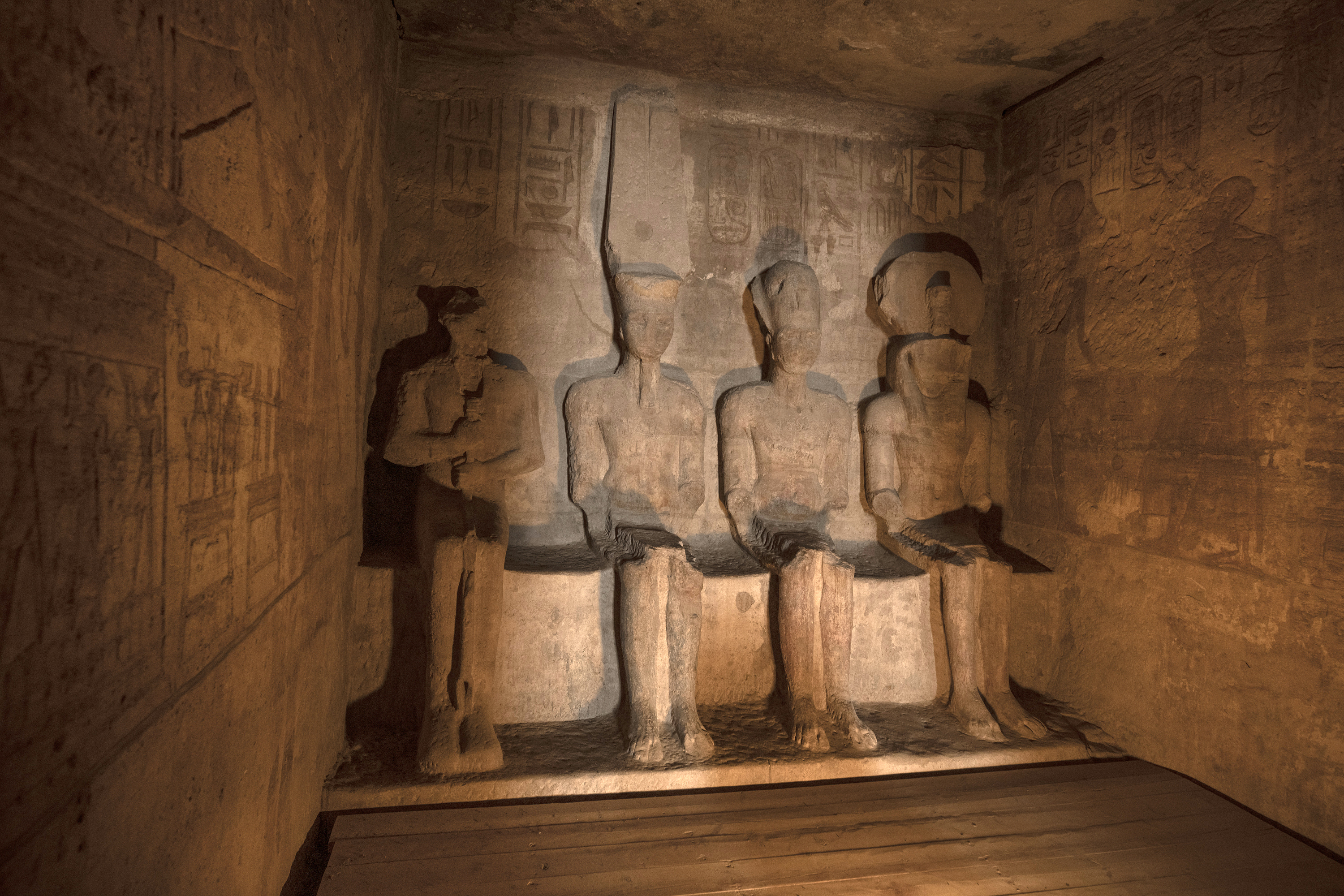
Immense statues led to a rear chamber, occupied by four sculptures depicting Ra-Horakhty, the deified Ramesses, and gods Amun-Ra and Ptah. Everything looked so natural, I could scarcely believe everything had been moved and reassembled. Venturing outside, I wandered over to the temple of Nefertiti, smaller in magnitude, yet equally impressive. During our visit, I counted 17 people, and our group accounted for eight of them!
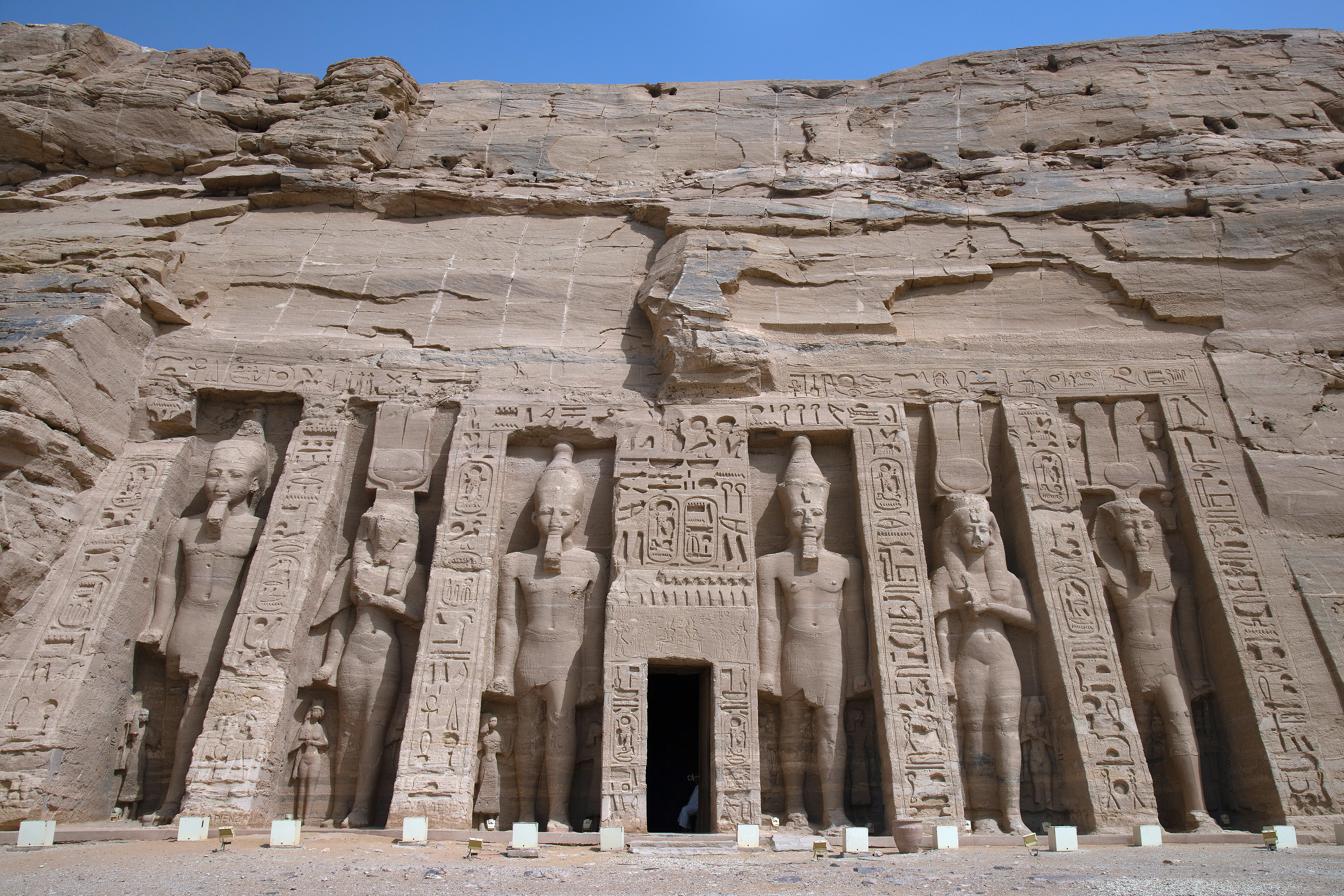
Heading back to the bus, the stalls had opened, and the vendors swarmed. An irritant, yes, but I could not be angry. Eighteen months without tourists had been rough, so I purchased a scarab beetle bottle opener. Back in Aswan by mid-afternoon, I stopped by the Old Cataract Hotel for afternoon tea. Radiating colonial elegance, it was where Agatha Christie penned Death on the Nile.
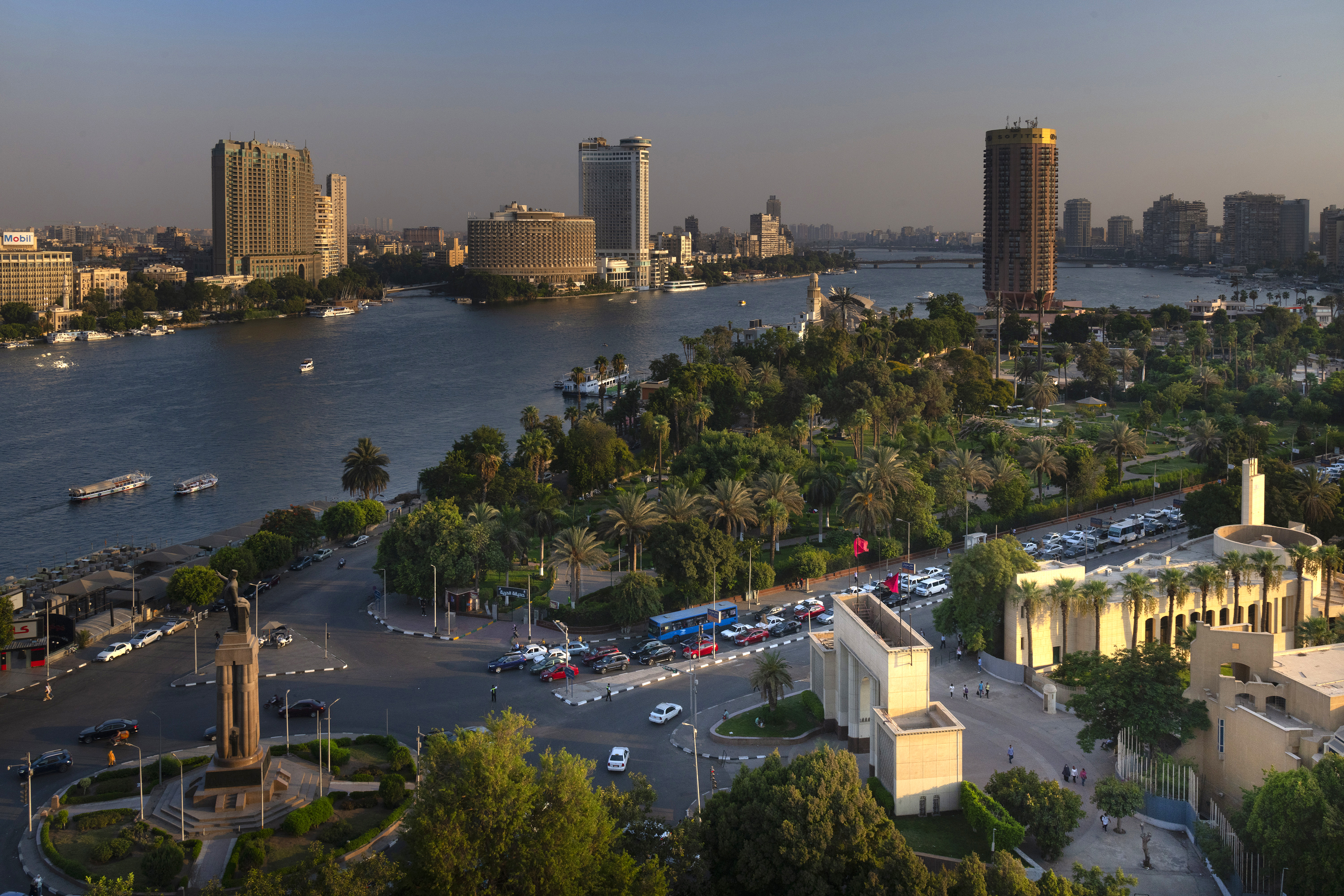
Off to Cairo
Bidding farewell to Mr. Ahmed, the next day saw the final leg of our journey as we boarded the overnight train to Cairo. Assigned my own sleeper compartment, the 13-hour journey was an adventure all by itself. A bit rough around the edges, it was hugely enjoyable, despite a few overnight lurches that nearly catapulted me out of bed. After breakfast, our mountain of luggage quickly dominated the corridor. With a mere ten-minute stop at Giza Station, we had to move fast!
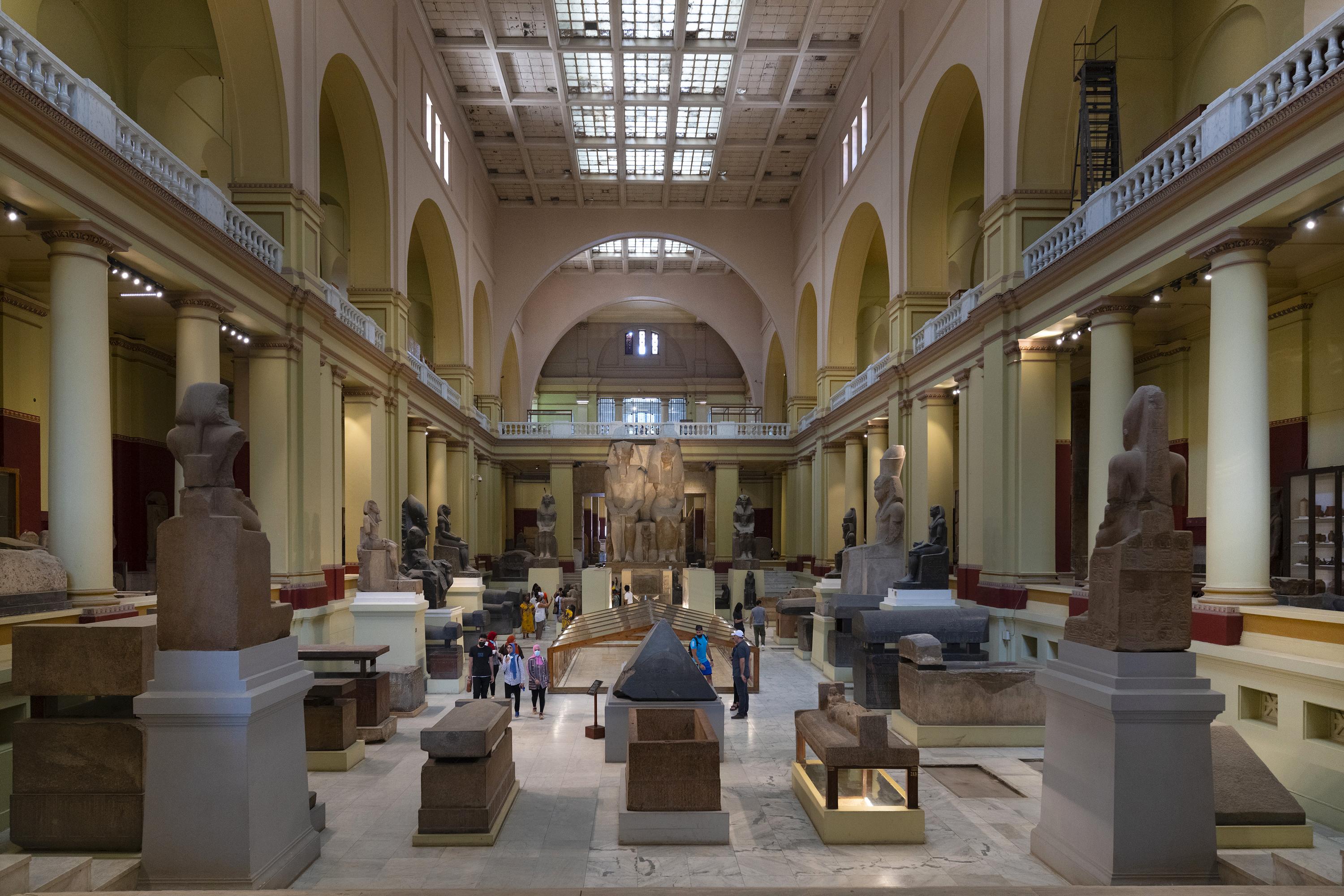
With all luggage and people accounted for, a 20-minute drive delivered us to the Novotel Cairo El Borg on Gezira Island, an oasis of green in the heart of Africa’s largest city. With a free day at our disposal, Cisca, the Belgians and I opted to visit the Museum of Egyptian Antiquities (also known as the Cairo Museum), located just across the Nile. Although much had been moved to the new Egyptian Grand Museum (STILL not open), a surprising amount remained on display, from delicate figurines to huge sarcophagi. The Tutankhamun artifacts were still there, while a separate room (no photos) exhibited the infamous golden mask. With crowds absent, I admired it from less than a metre away.
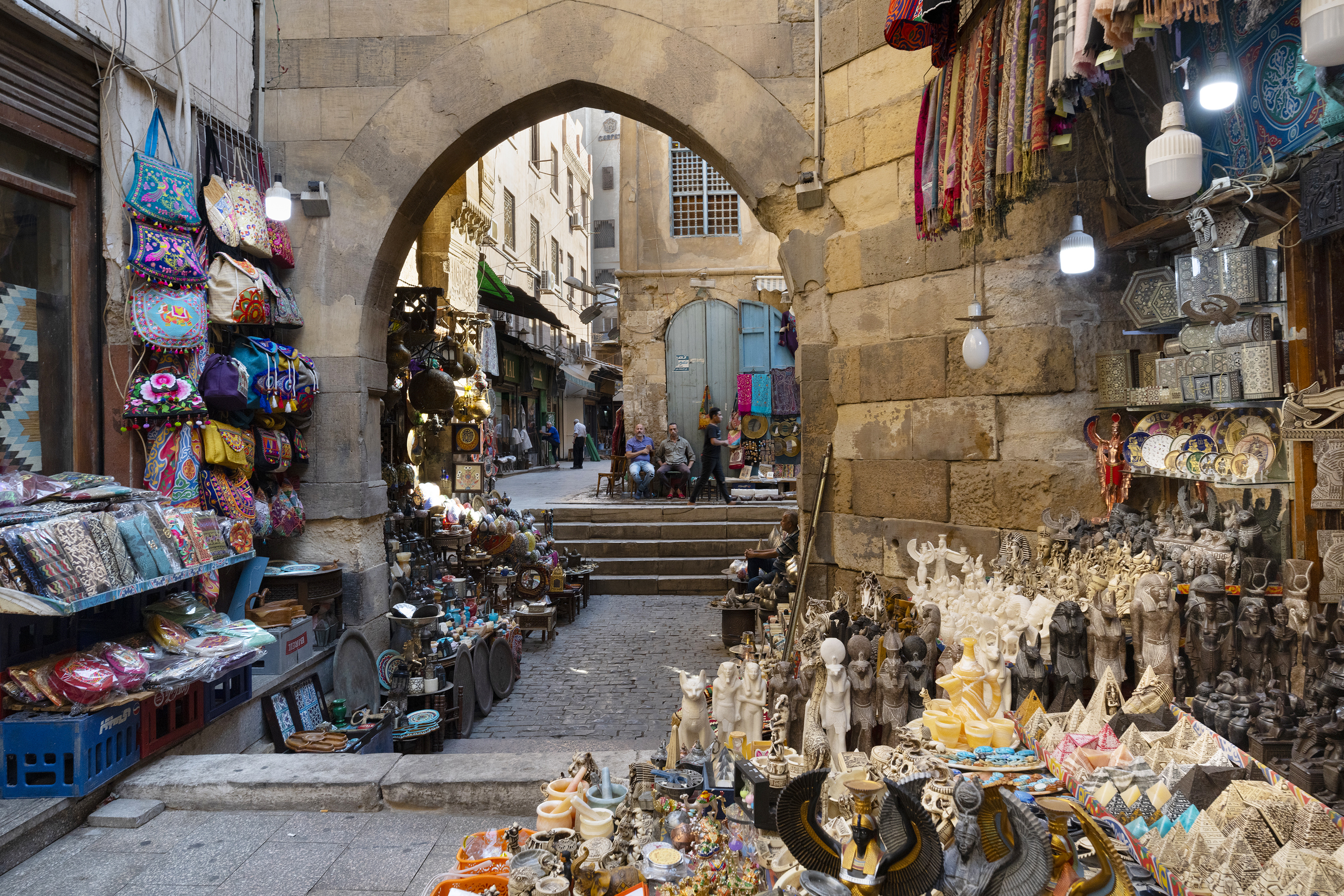
Khan el-Khalili
Afterwards, we arranged to meet the others at Khan el-Khalili, the sprawling bazaar in the city centre. Grabbing taxis, we set out across Tahir Square’s chaotic traffic circle before passing elegant yet tattered French colonial buildings. Twenty minutes in a Cairo taxi rivals any amusement park ride for thrills and flashes of sheer terror!
Finding the others amid the chaos seemed insurmountable, yet somehow, we did. Ornate gates and facades adorned labyrinthine alleys, the bewildering array of stalls selling everything from spices and incense to shishas, pharaoh busts and gold bikinis. I could have spent hours perusing the bazaar, but Cisca had arranged for my PCR test at the hotel, necessitating an early departure.
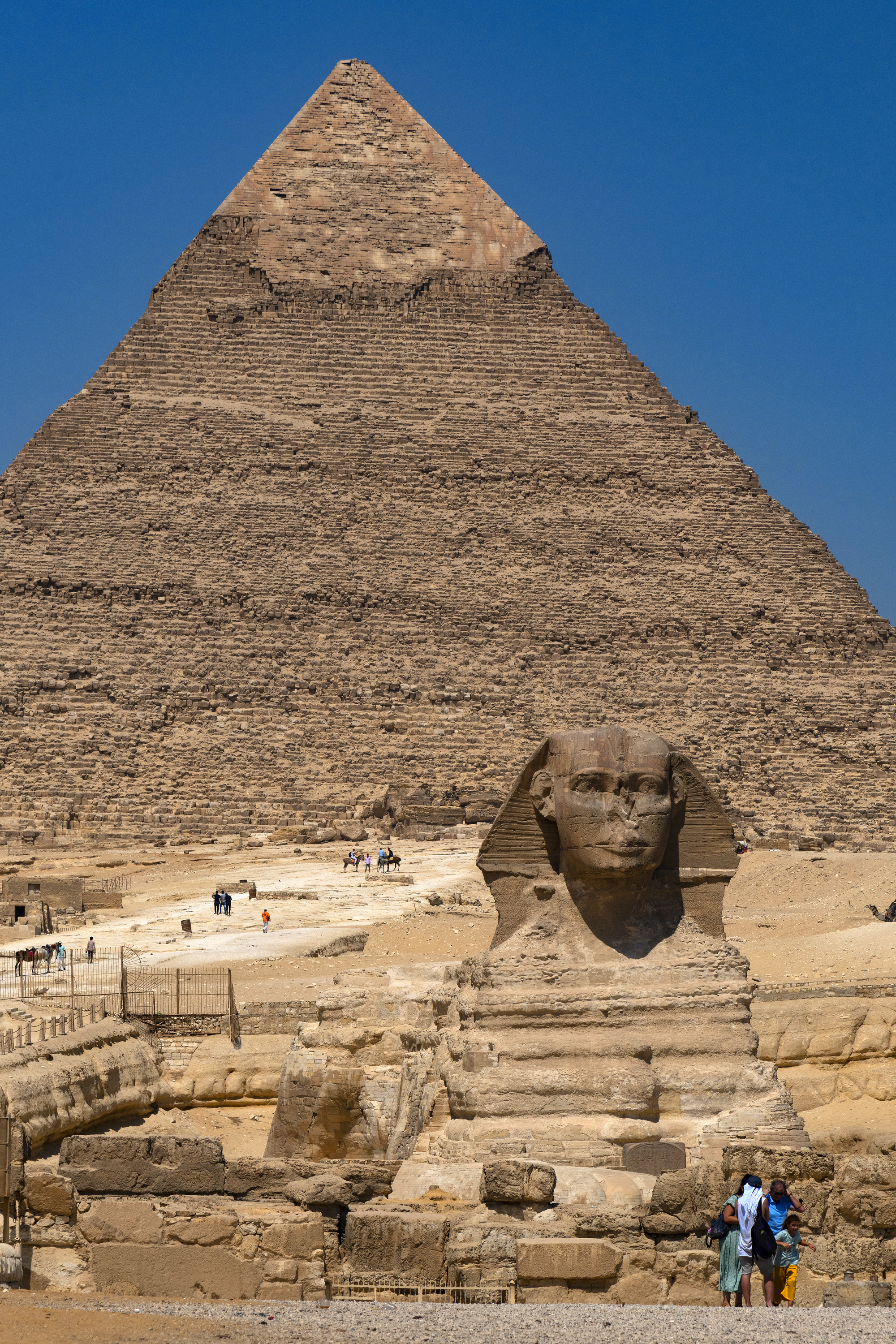
Giza Plateau
Our final day saved the best for last. Poised between golden dunes and sprawling suburbs, the Giza Plateau literally personifies Egypt. We have all seen the pyramids on TV, films and media, but nothing compares to the real deal. To actually stand in front of the Khufu, or Great Pyramid, is simply awe-inspiring. The embodiment of history, approximately 2.3 million blocks of stone create the 5.75-million-ton structure.
I did not go inside the Great Chamber (it cost 400 Egyptian pounds and cameras were forbidden) but explored the exterior, marvelling as to how the massive blocks were even moved. A short drive brought us to Giza’s other icon. The Sphinx was equally impressive and bigger than I expected. I asked our guide what he thought about the theories that it is much older than the accepted 2520 BCE. “Oh, I wouldn’t be at all surprised,” he mused. “Just don’t bring up the subject of ETs—the government really hates that!”
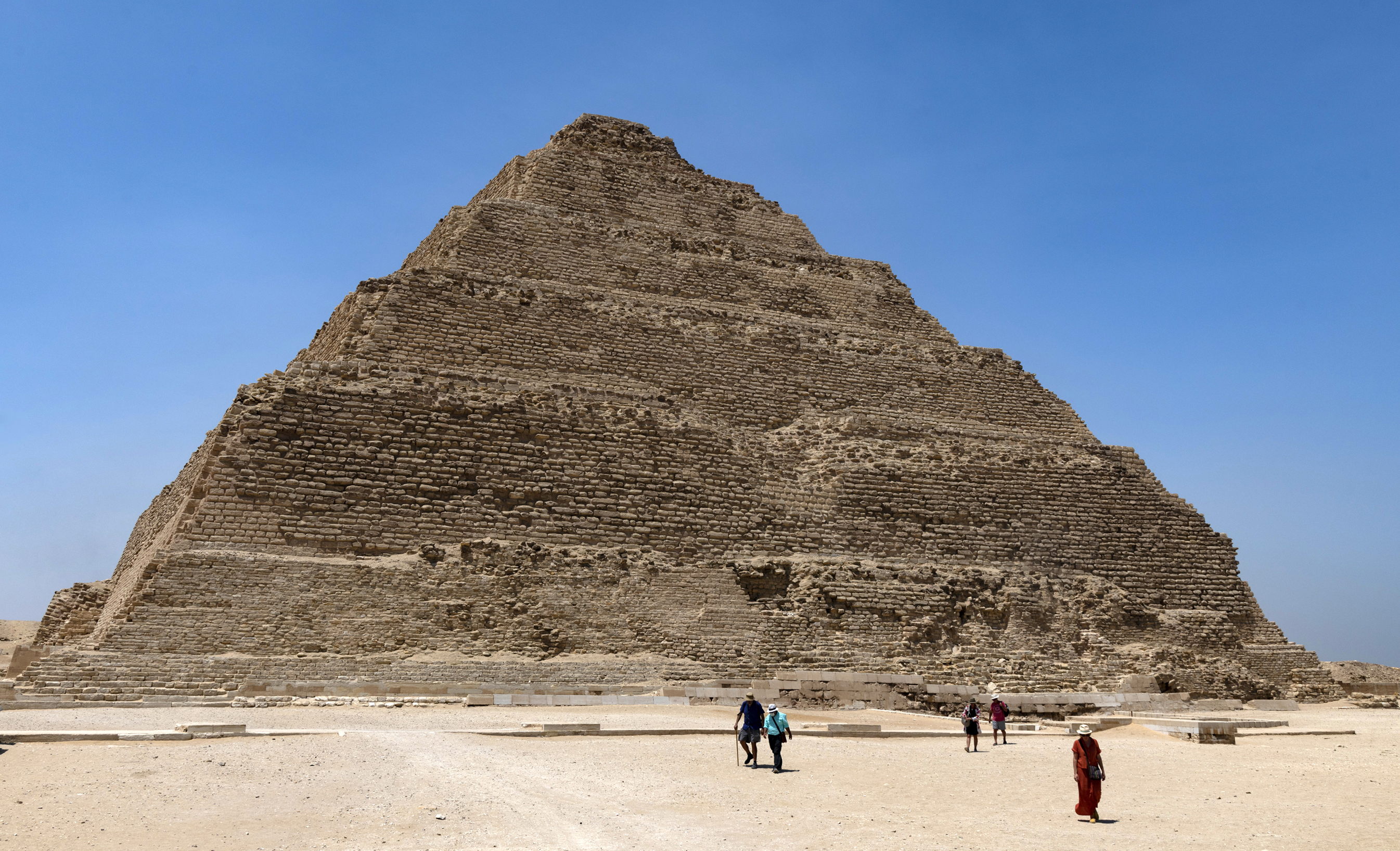
Saqqara
Afterwards, we drove out of town to Saqqara for our final stop. Constructed 4,700 years ago, the Step Pyramid of Djoser is regarded by many archaeologists to be the very first large-scale cut stone pyramid. Consisting of six terraces 60m high, it is also considered by many to be the oldest known ancient Egyptian stone structure. Recently, a funerary temple was found, along with a burial shaft containing 3,000-year-old coffins. Clearly, Egypt has many more secrets to reveal.
After a full-on day, I debated whether to visit Islamic Cairo, but both camera and I were exhausted. Cairo is an amazing city, its sights overwhelming, and a return visit (or two) is definitely in order.
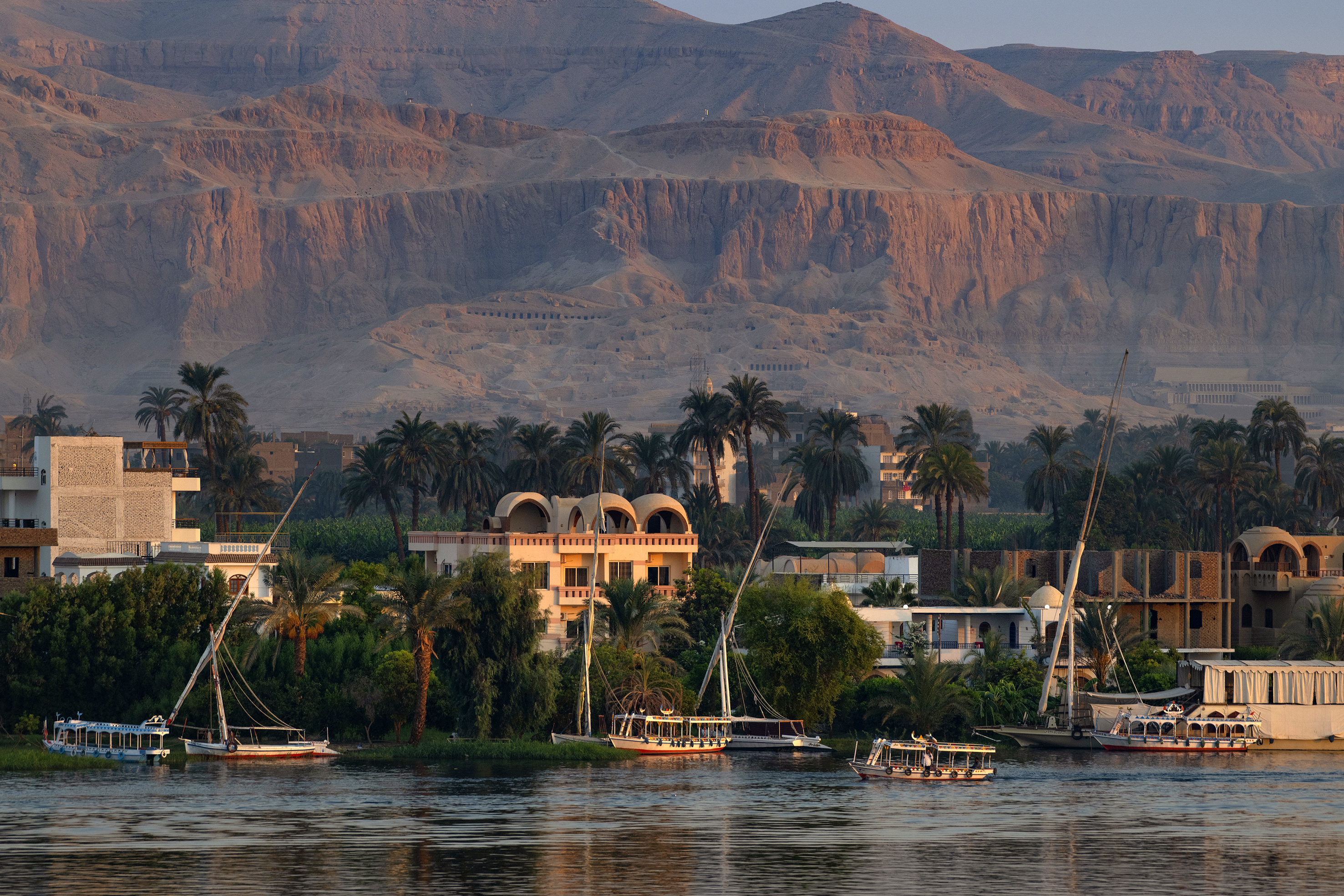
Afterthoughts
In the end, Egypt was everything I had hoped for and more. Despite the inconvenience of PCR tests and masks, travelling during the Covid-19 pandemic presented a unique benefit: experiencing Egypt without the crowds. It was an extraordinary privilege, and one likely never to be repeated.
If the Covid-19 pandemic taught us anything, it illustrated the complacency of “someday.” Life is short and opportunities precious. With travel slowly returning to a state of normalcy, now is the perfect time to go. Each day on the trip, I counted my blessings. Like many businesses, dive operators suffered greatly during the pandemic and need your business. As long as sensible precautions are observed, travel is not just possible but easy. Just go! ■
Thanks go to the African & Oriental Travel Company (orientafricatravel.com) and Red Sea Explorers (redseaexplorers.com).
Associate editor Scott Bennett is a widely published underwater photographer and dive travel writer based in Toronto, Canada, covering the Caribbean, Mediterranean, Red Sea, Europe, Africa, Southeast Asia, Oceania, South and East Pacific. See more of his stories at: xray-mag.com/Contributors/Scott-Bennett
SOURCE – Egyptian tombs: en.wikipedia.org/wiki/Portal:Ancient_Egypt

